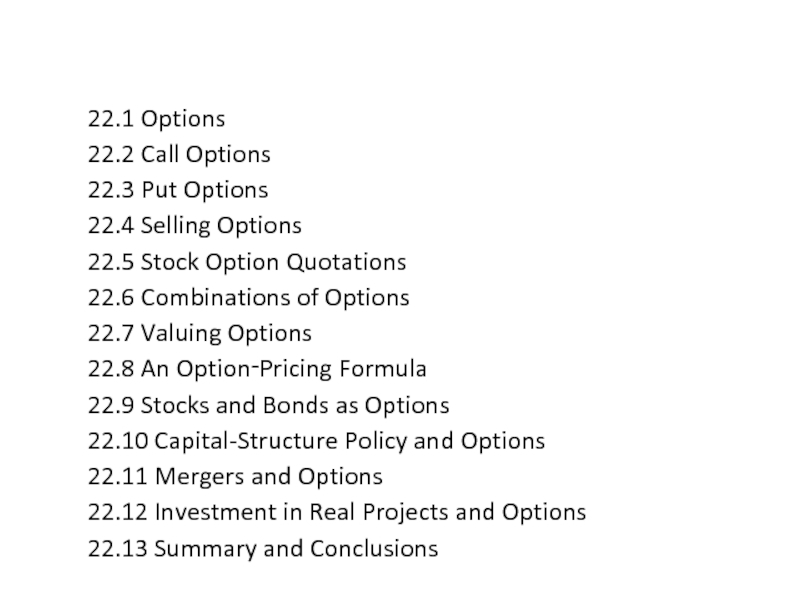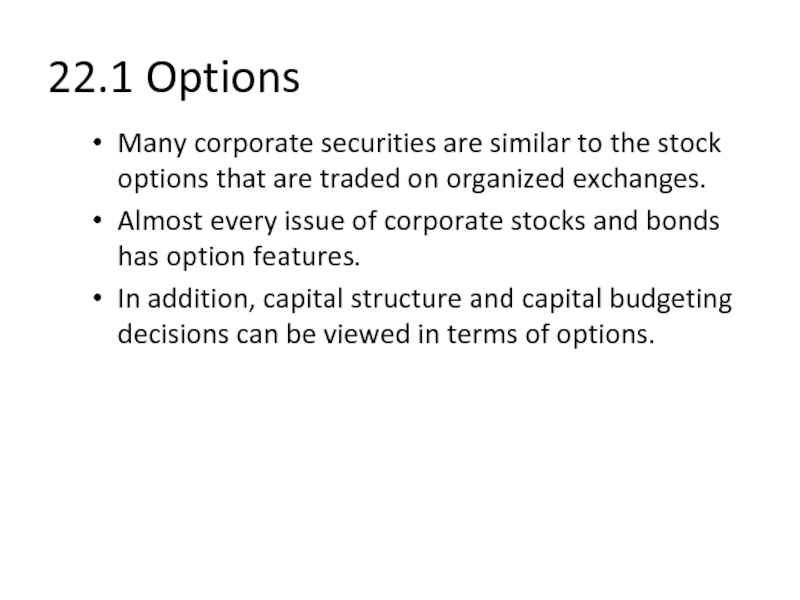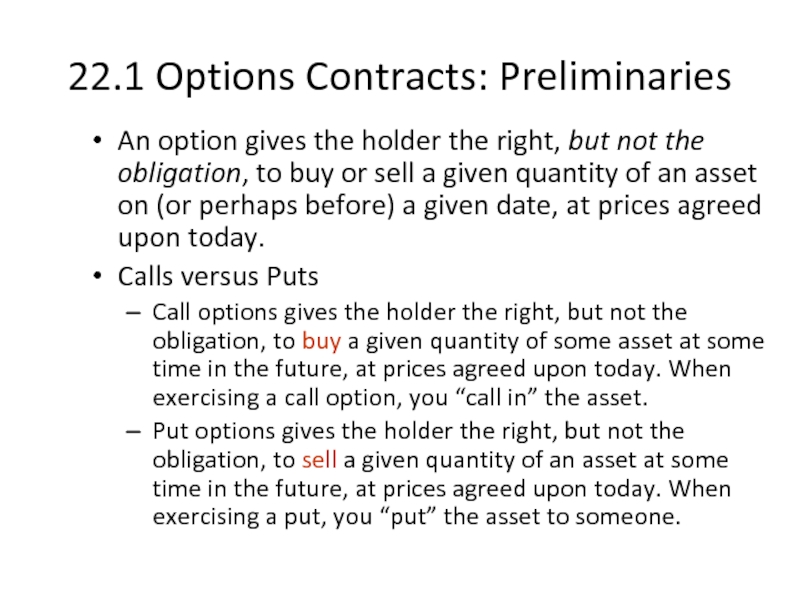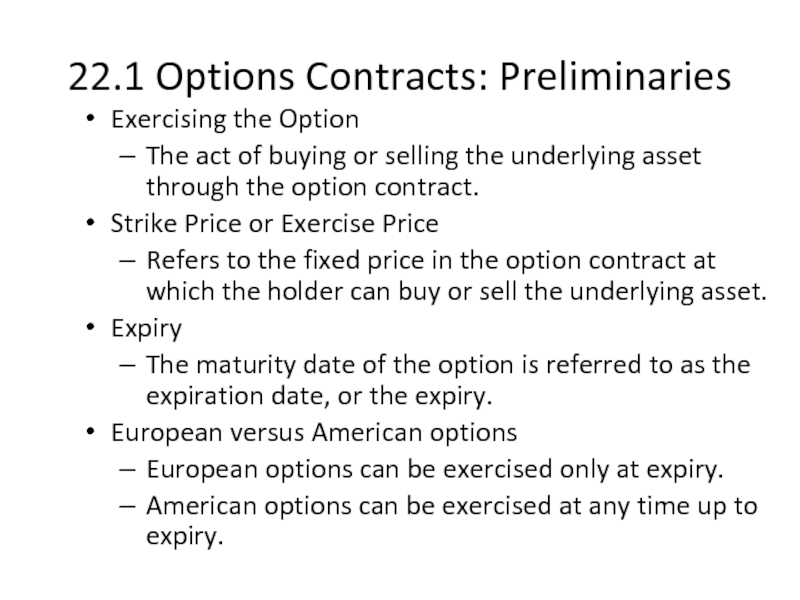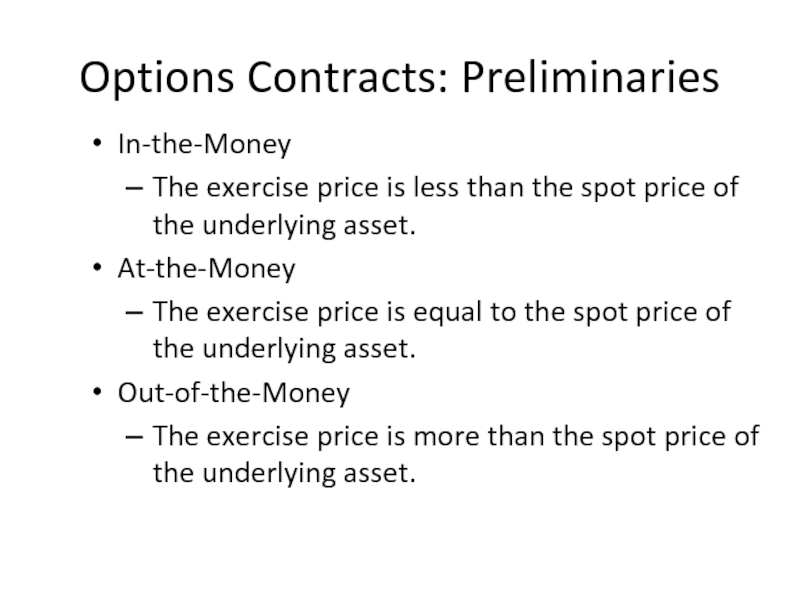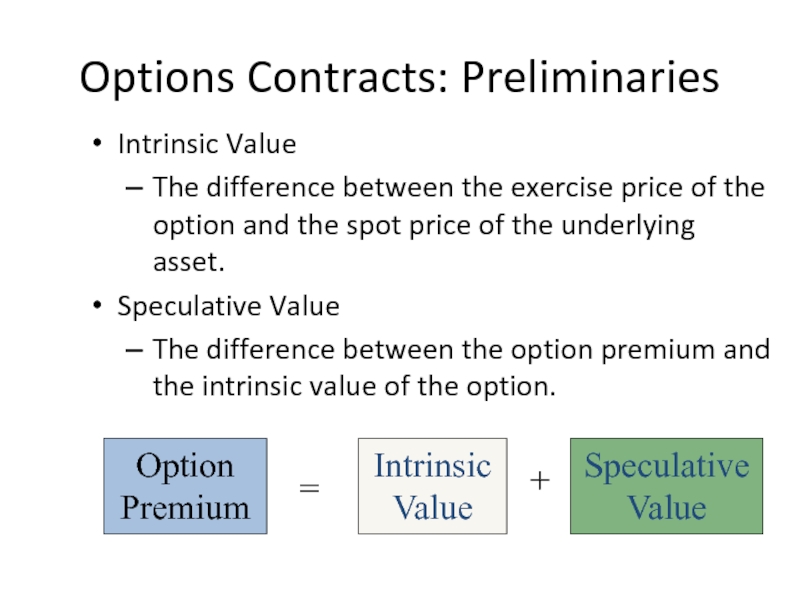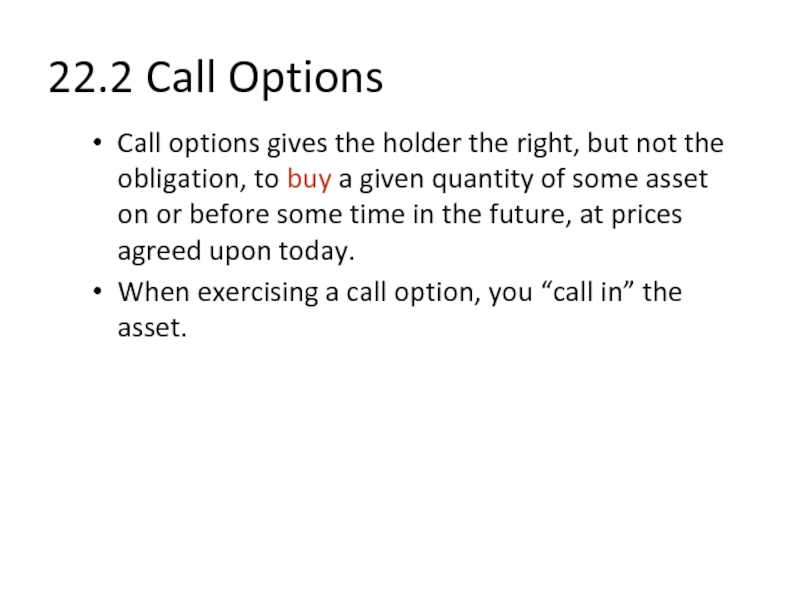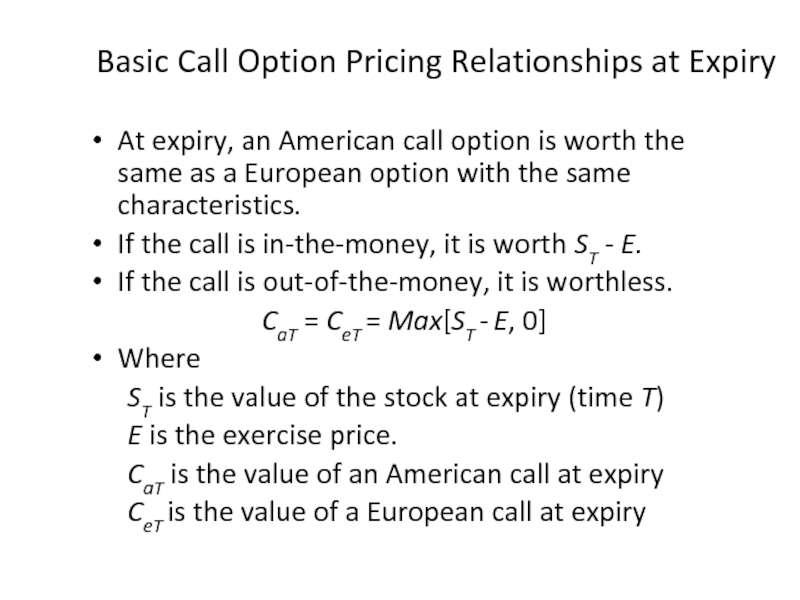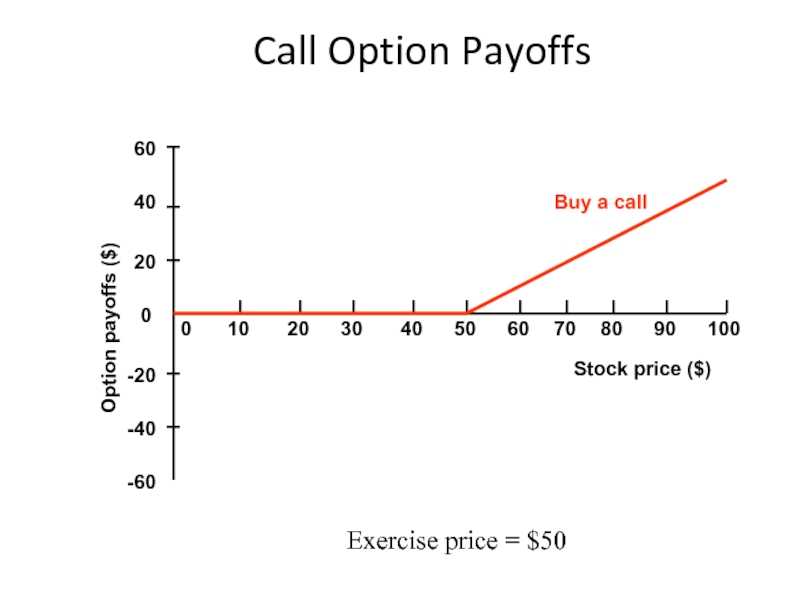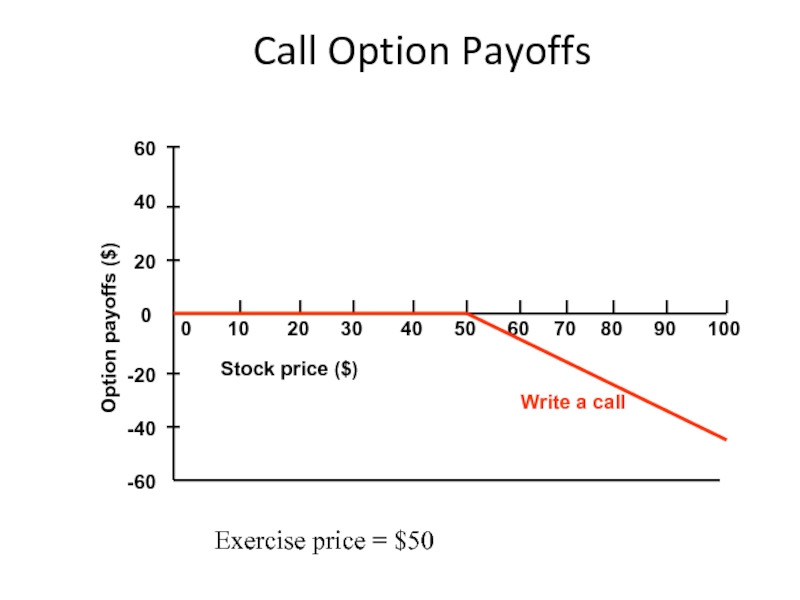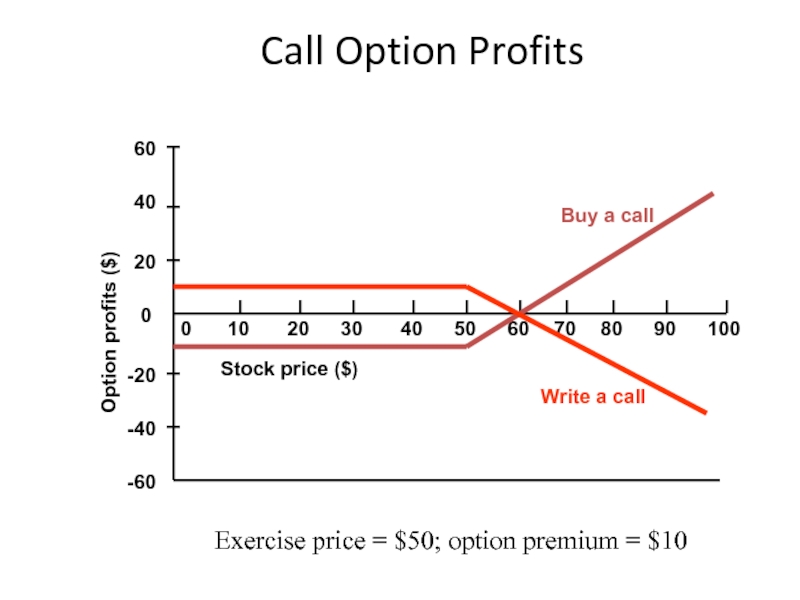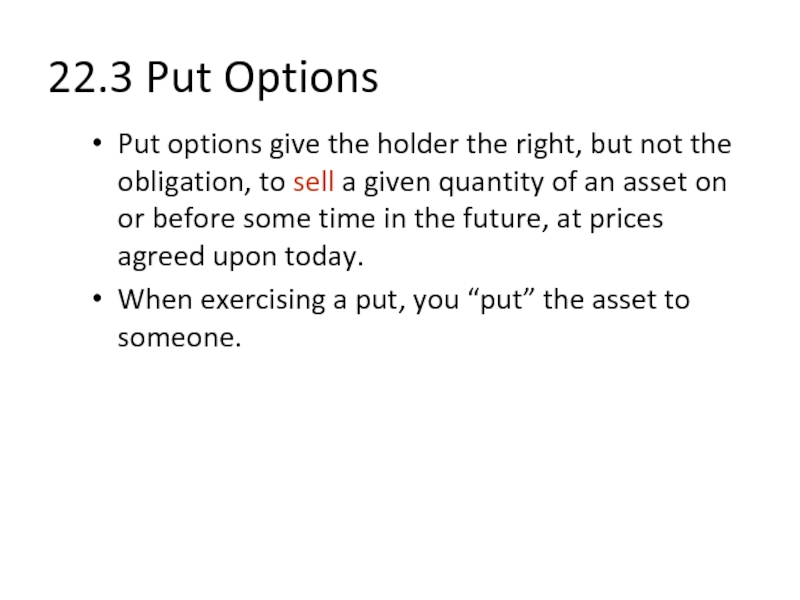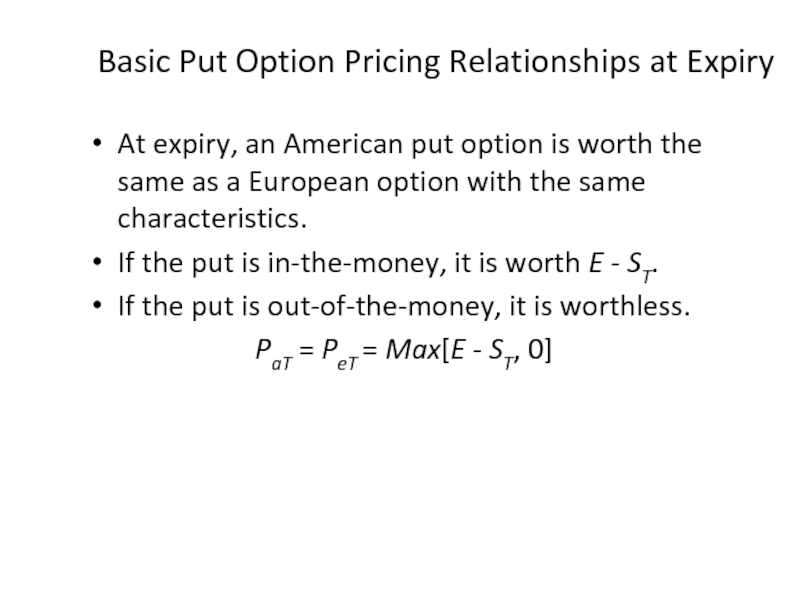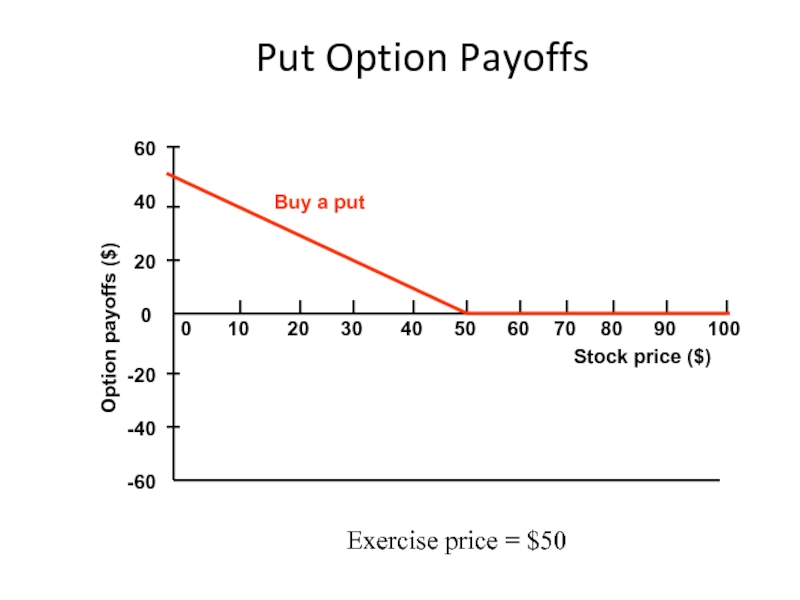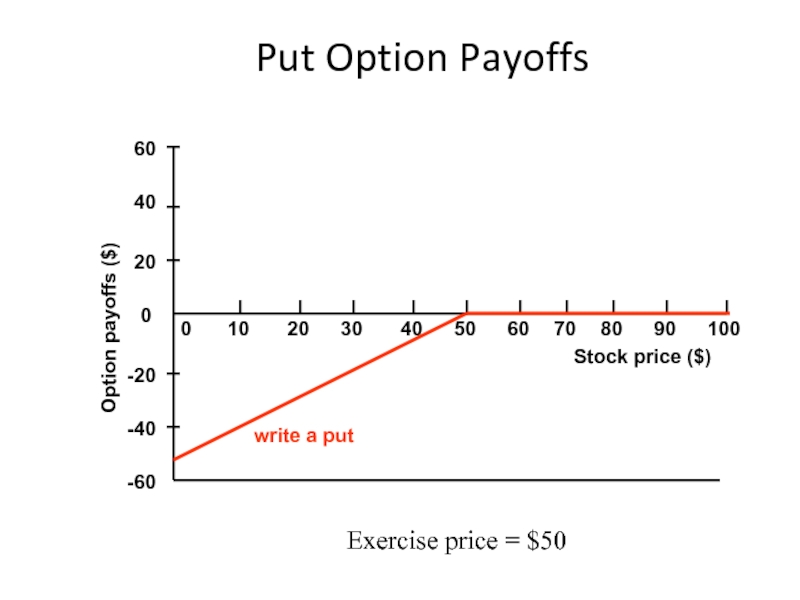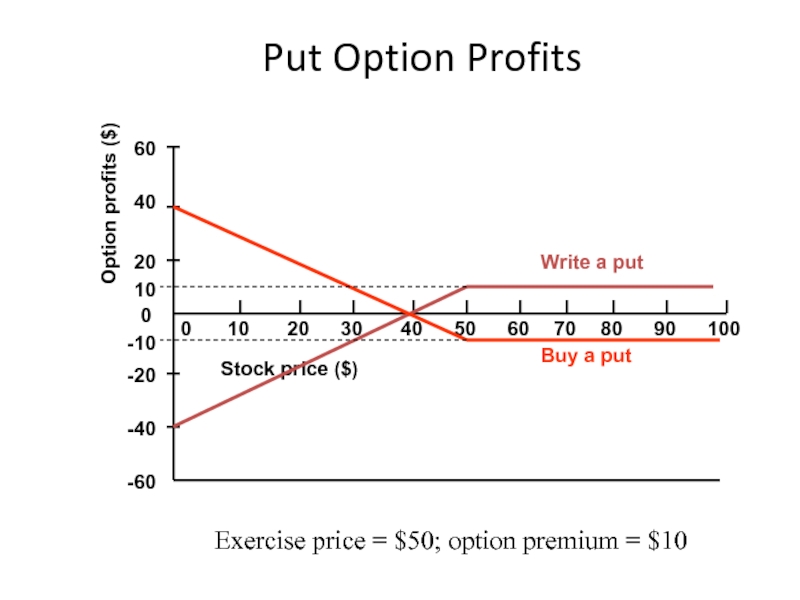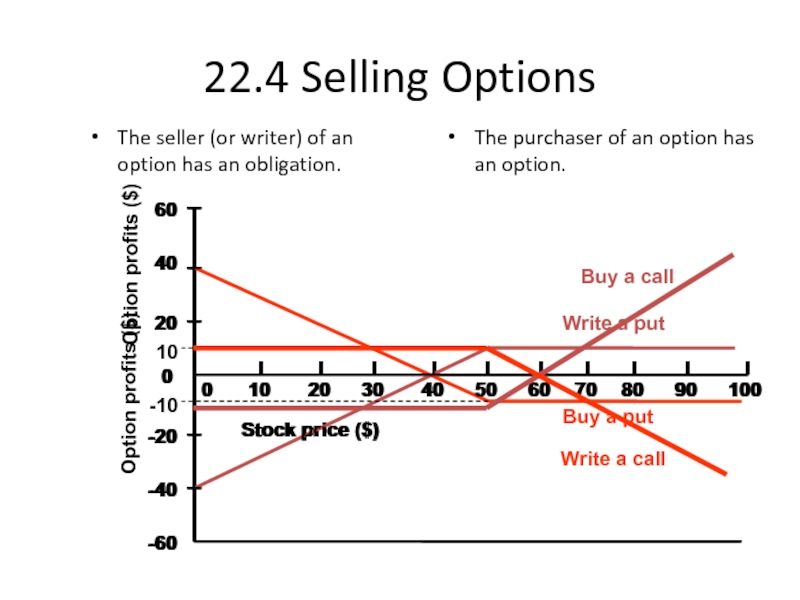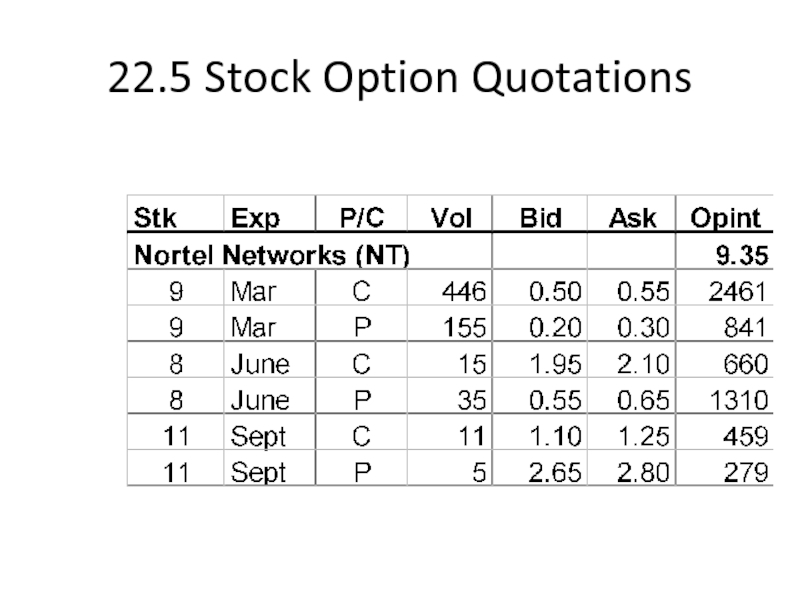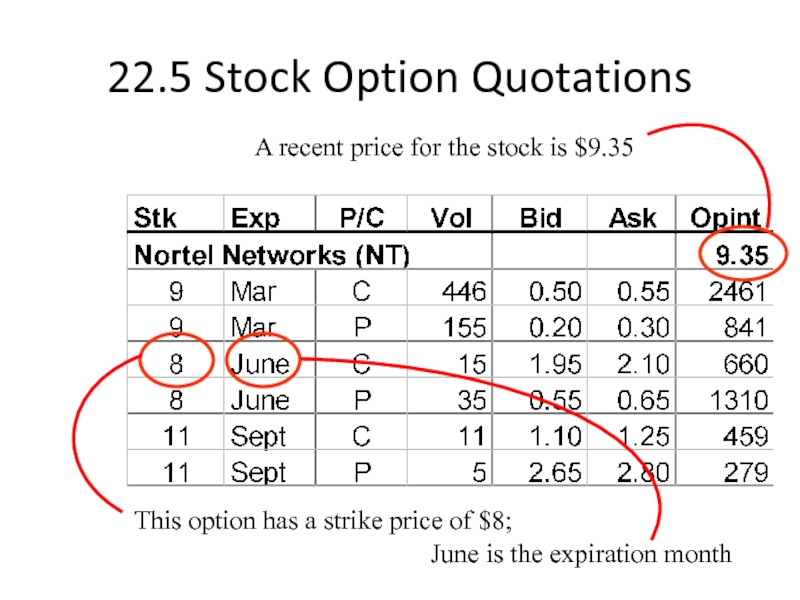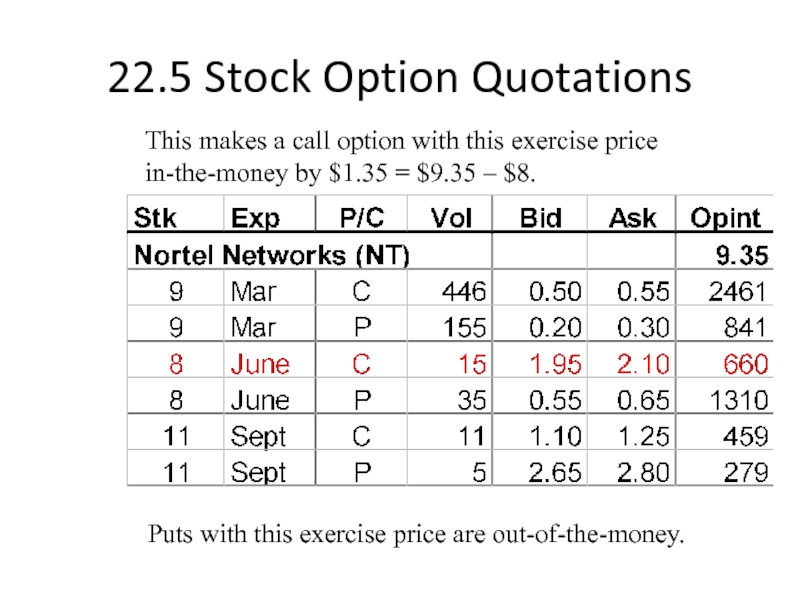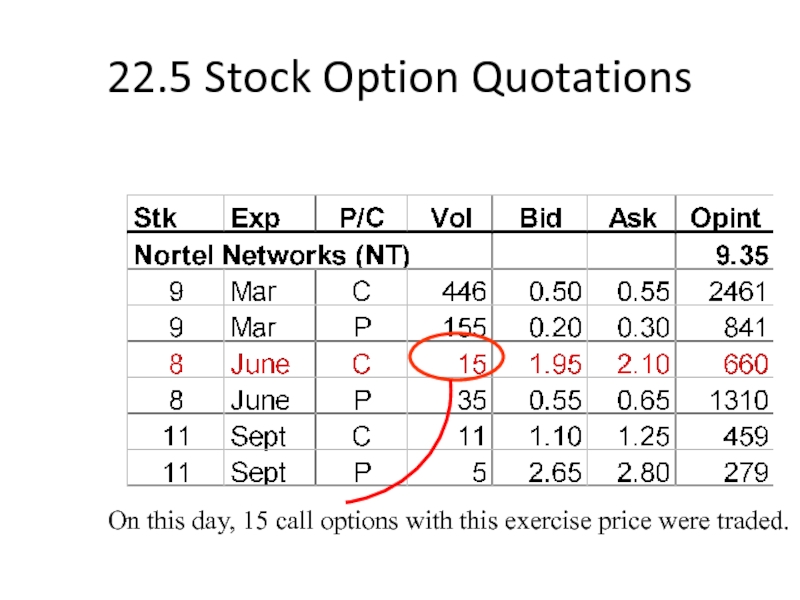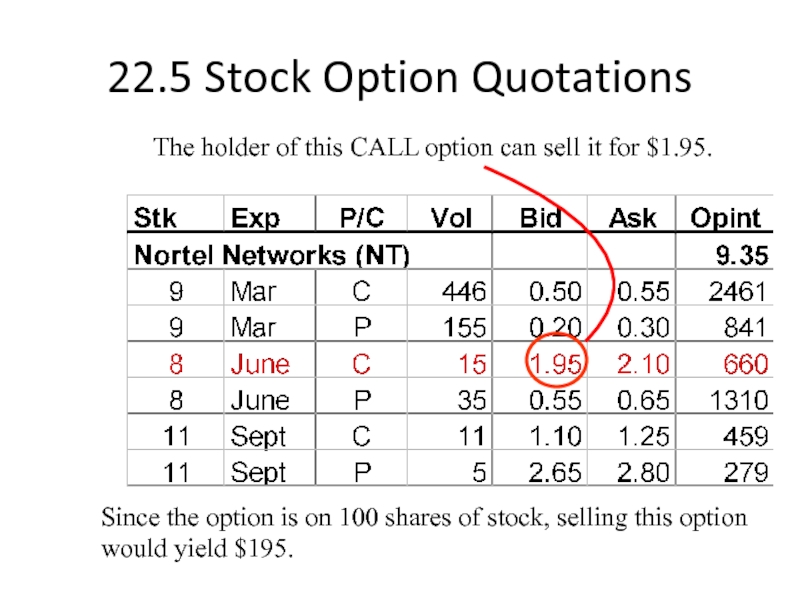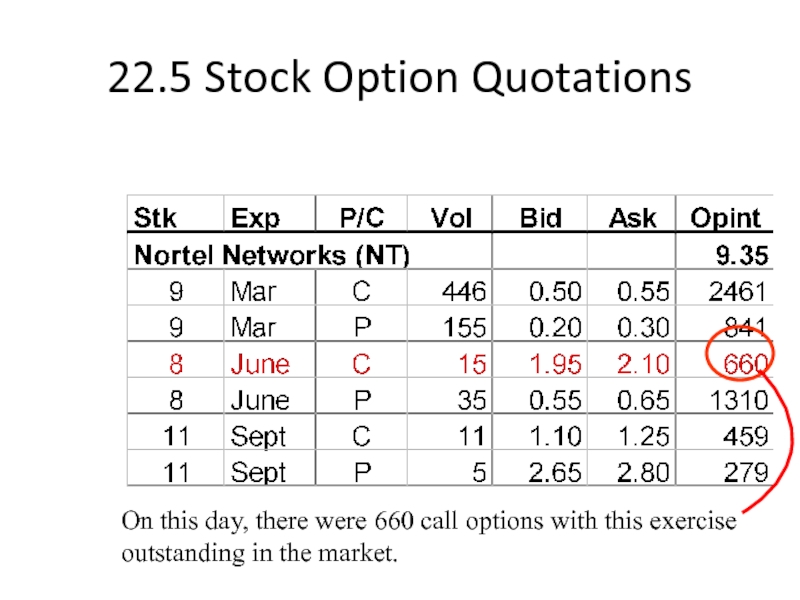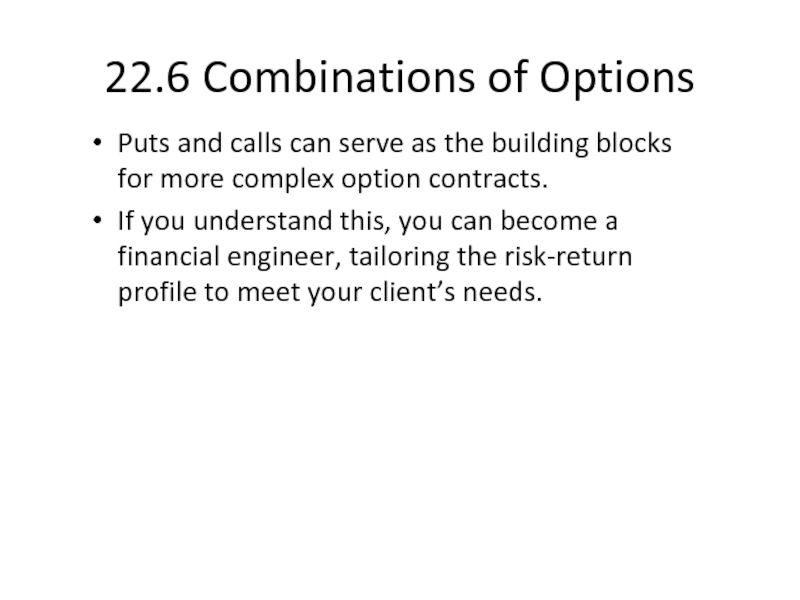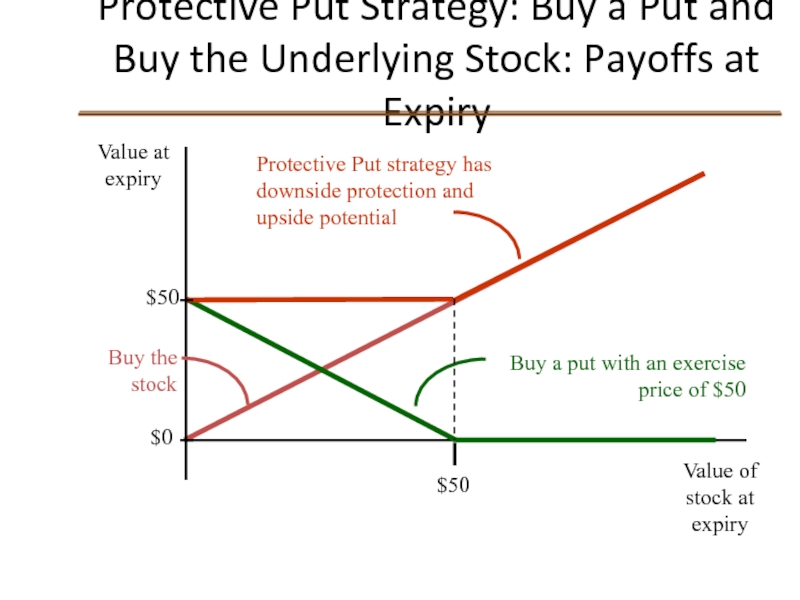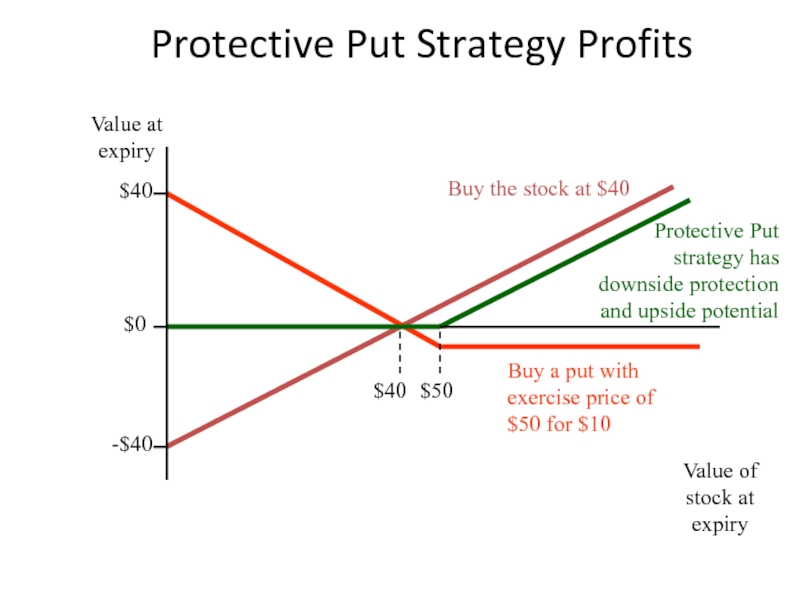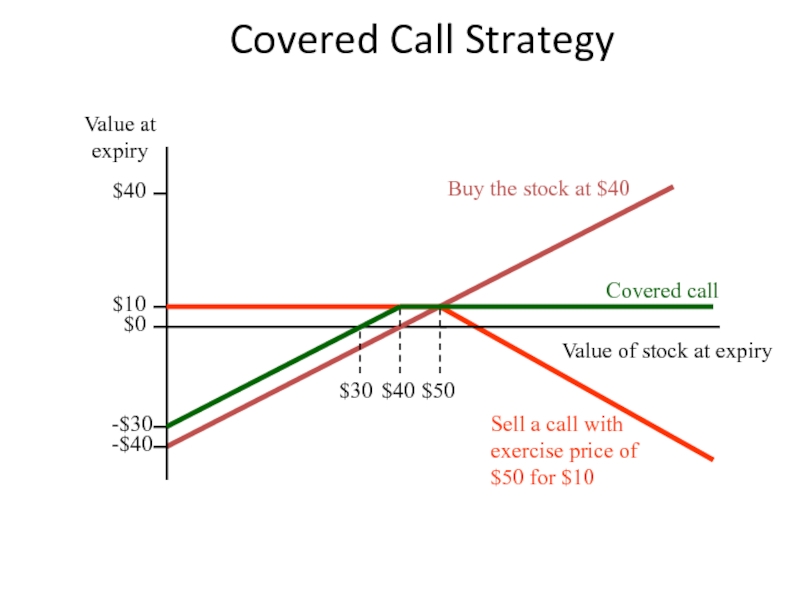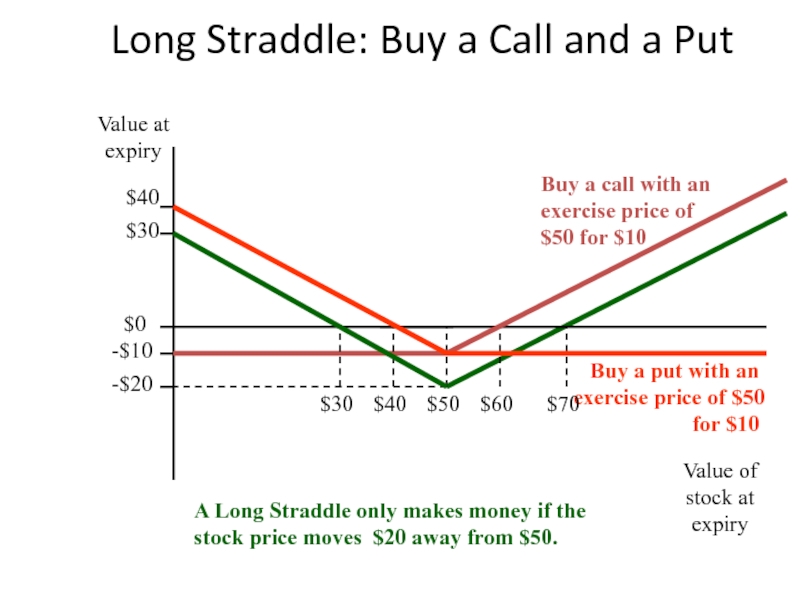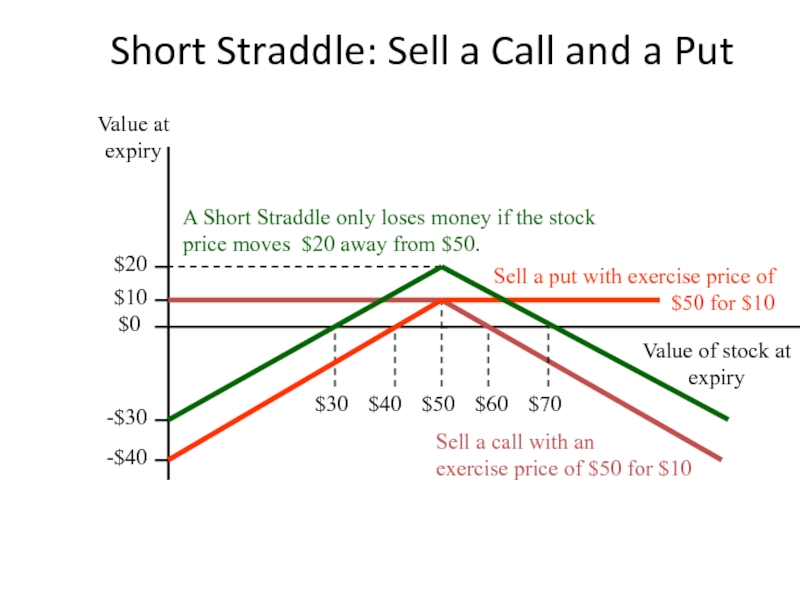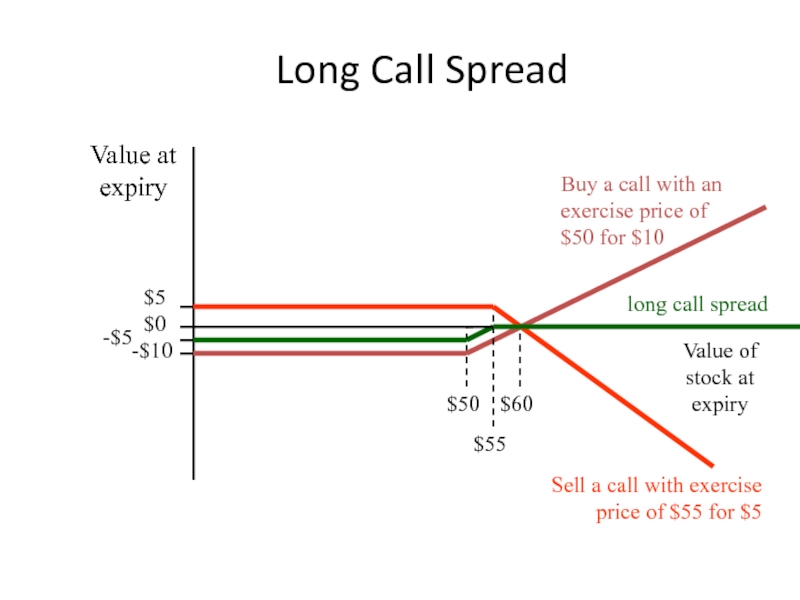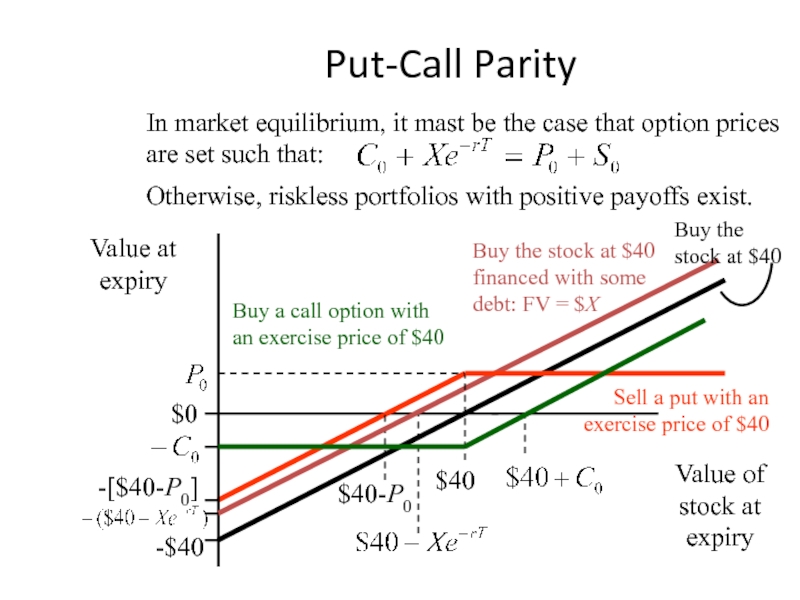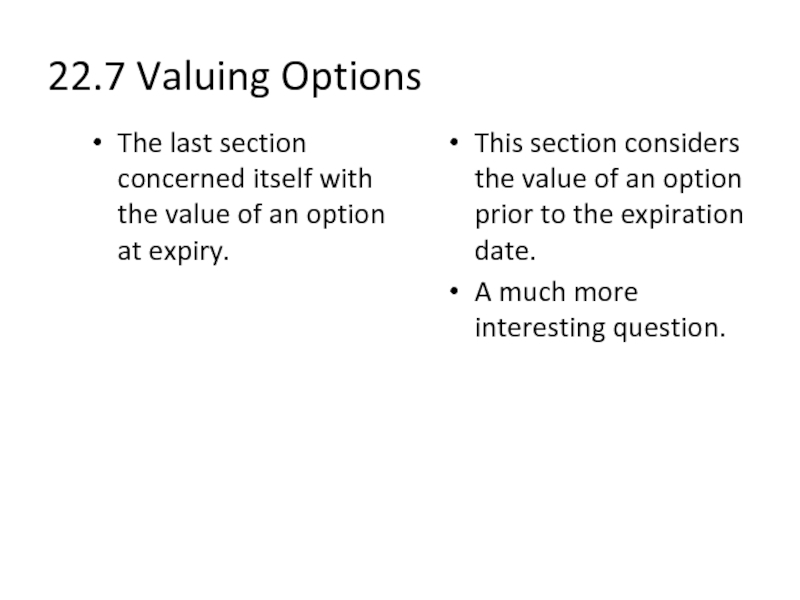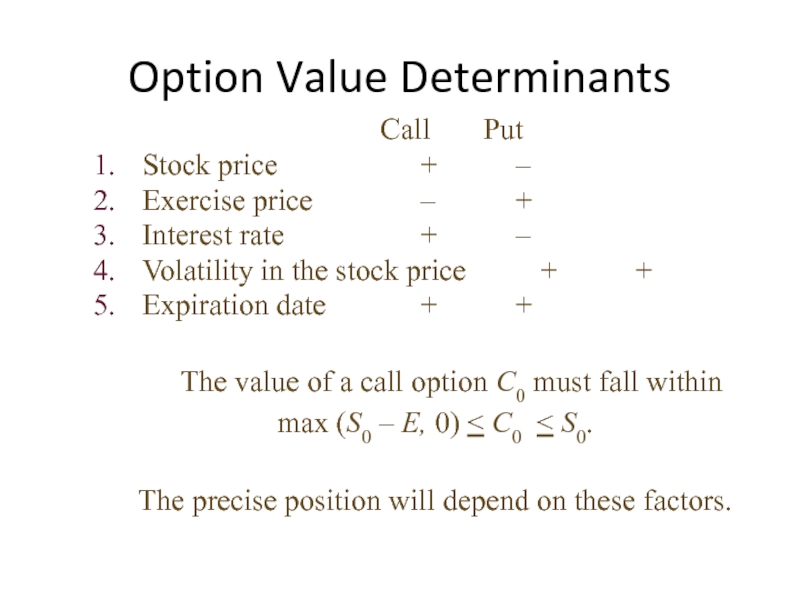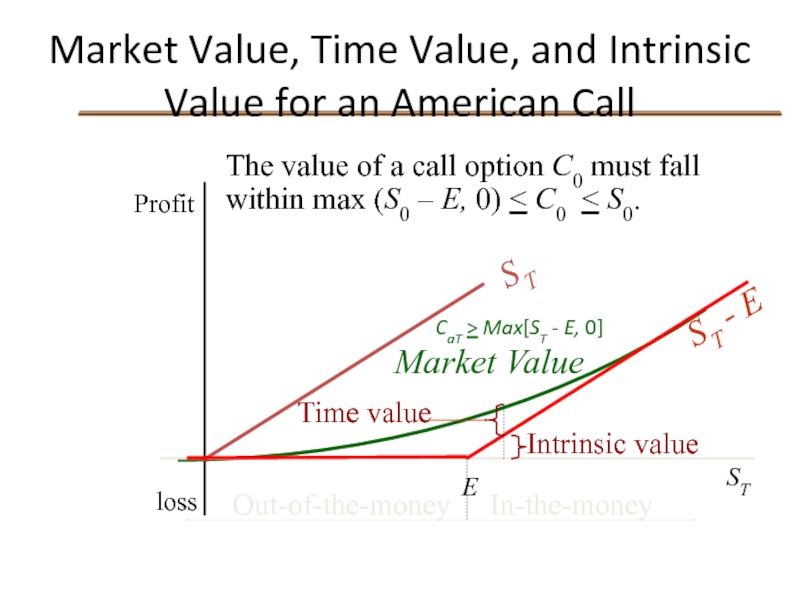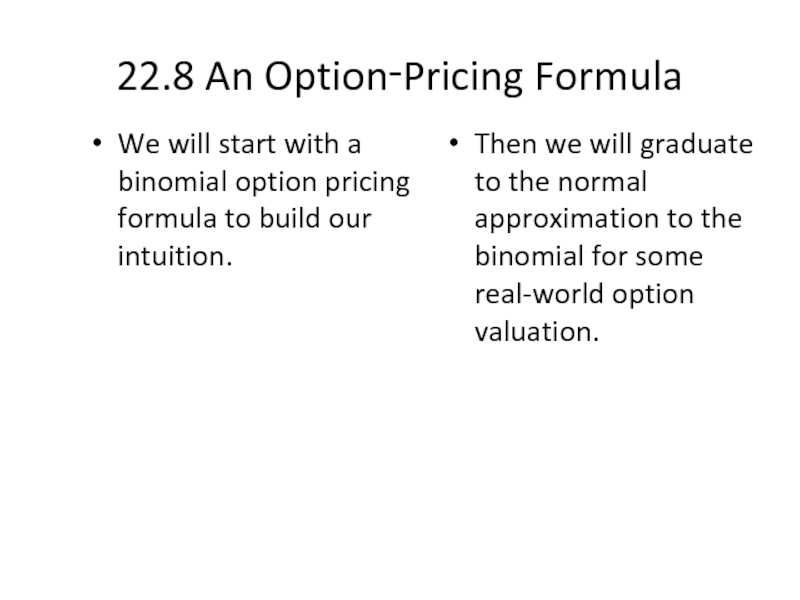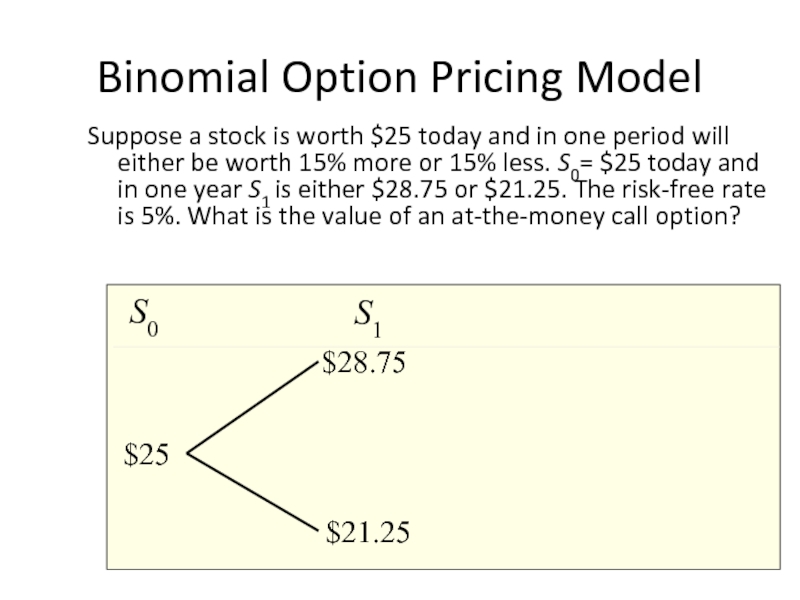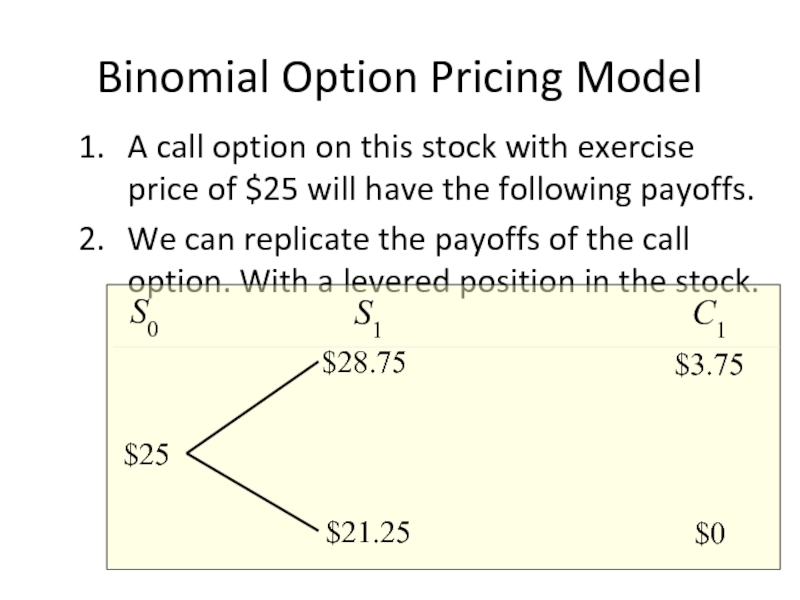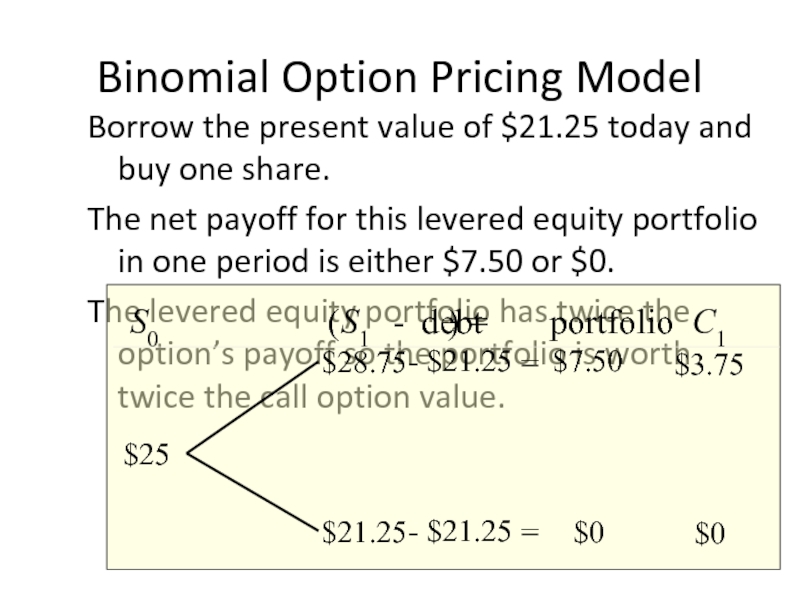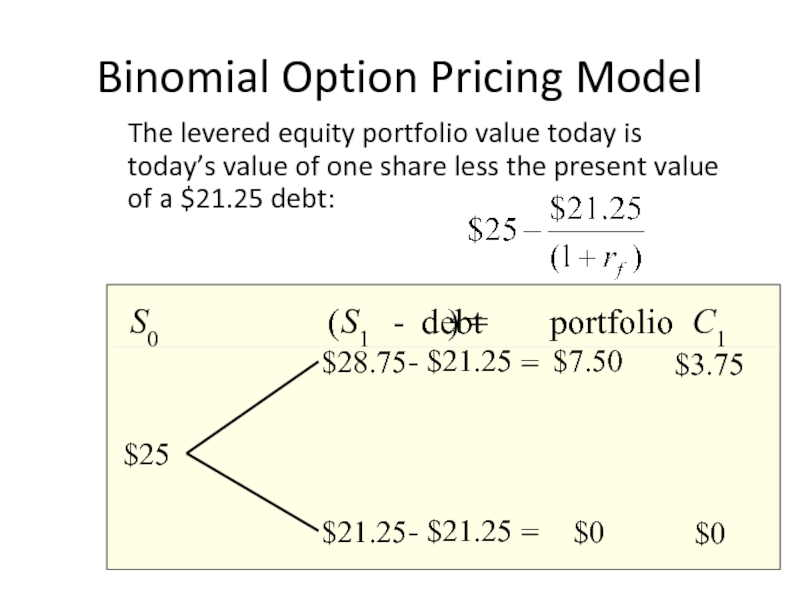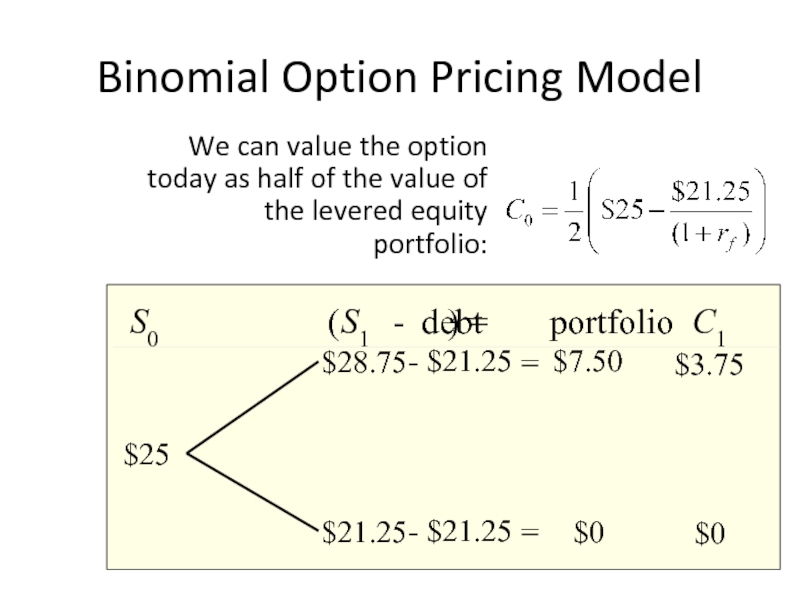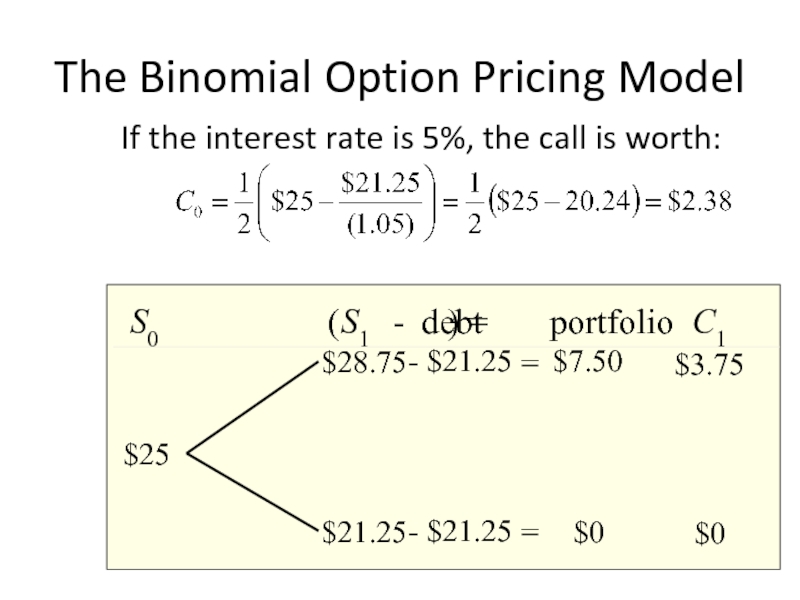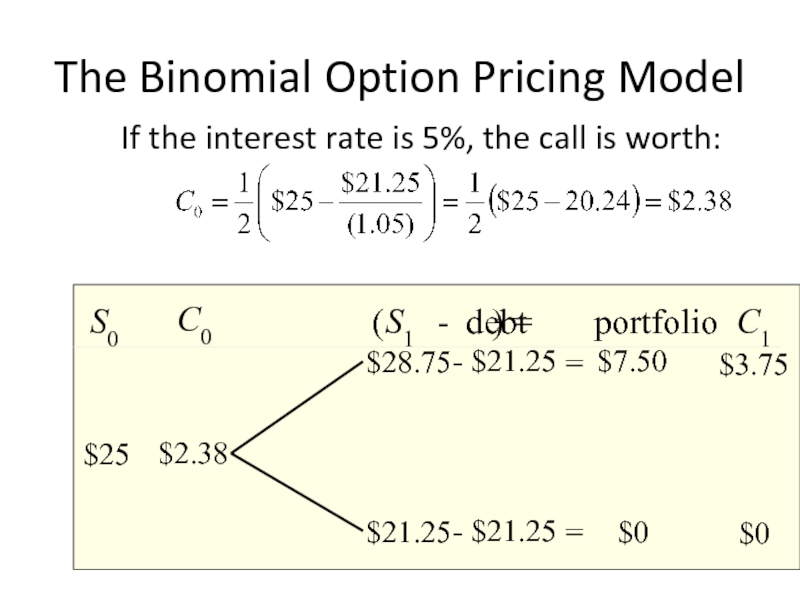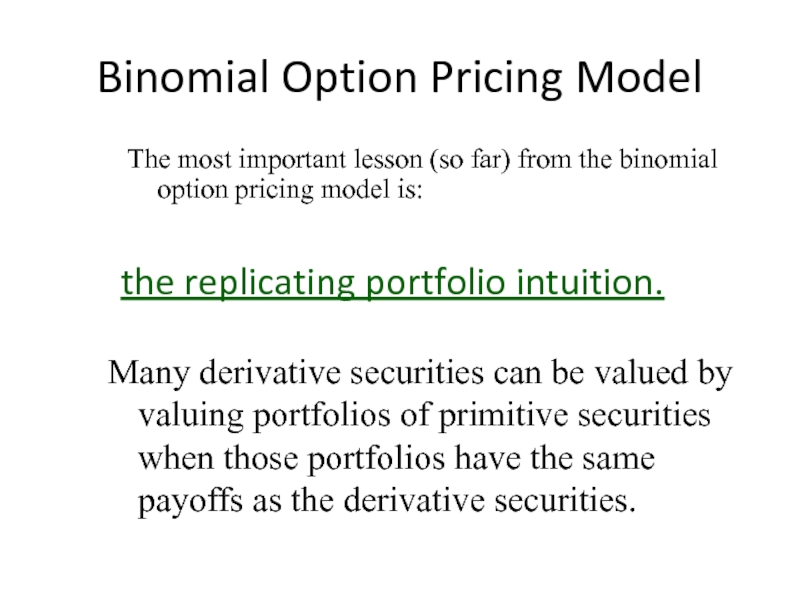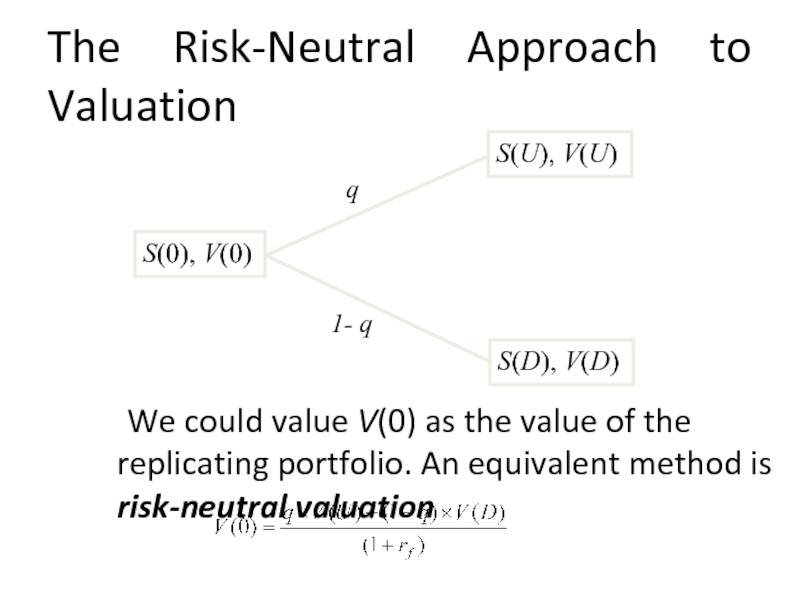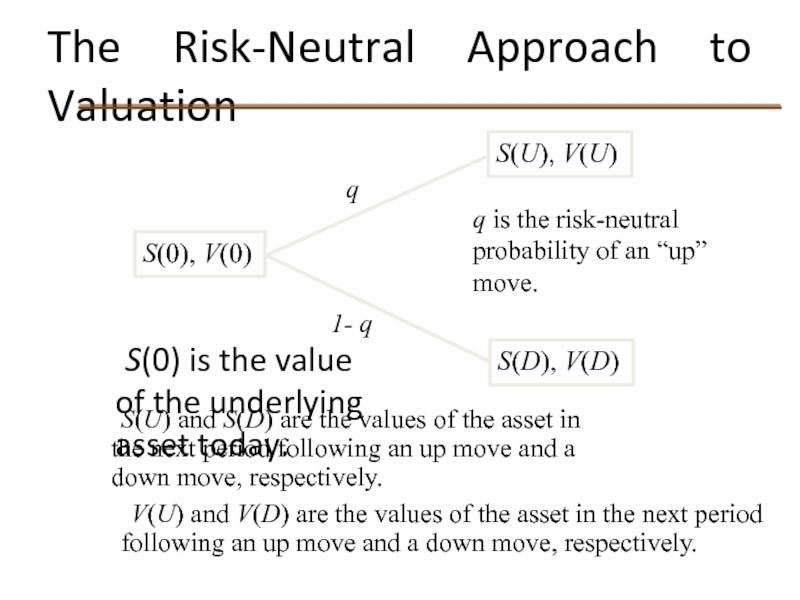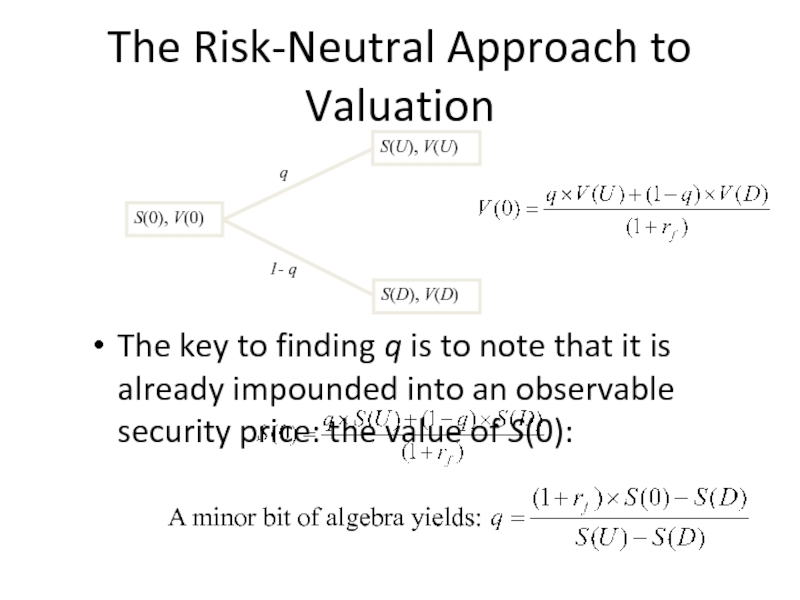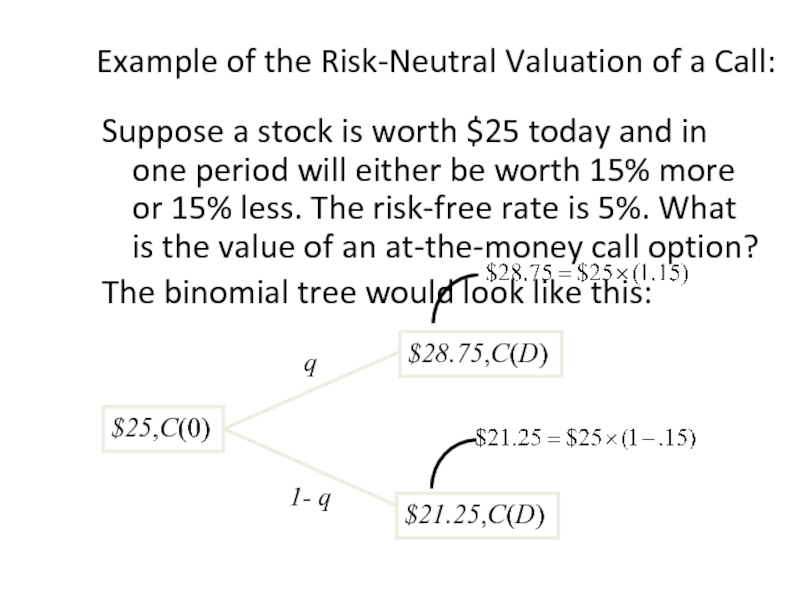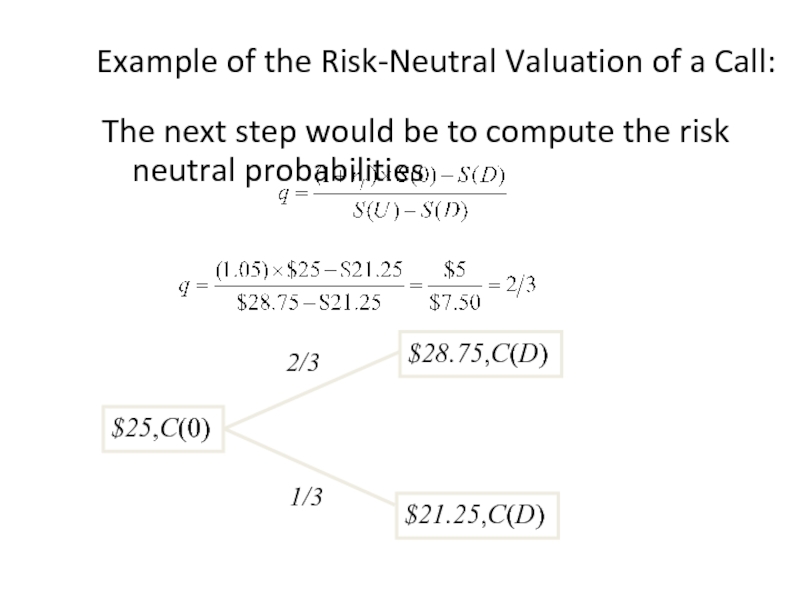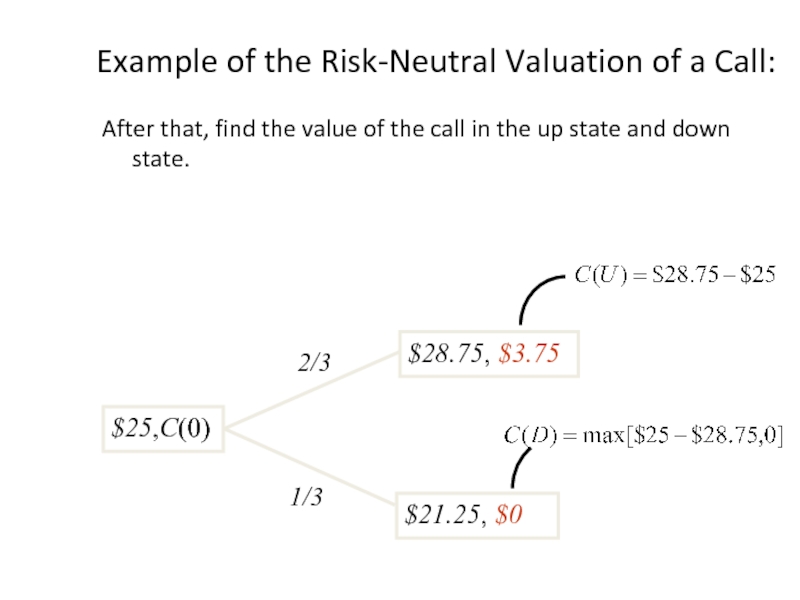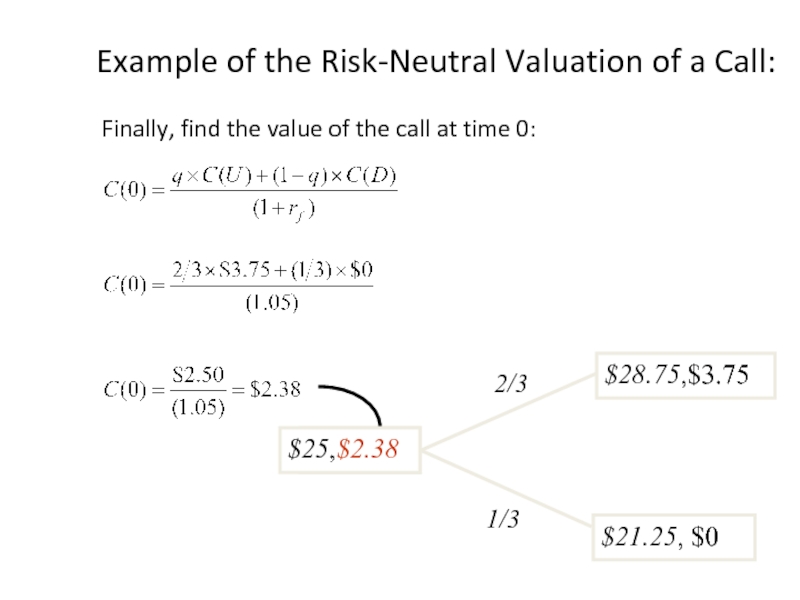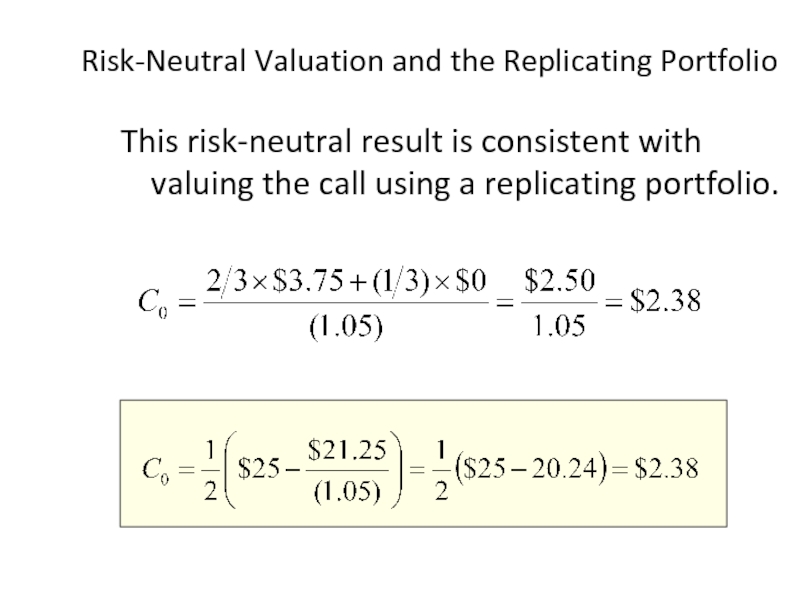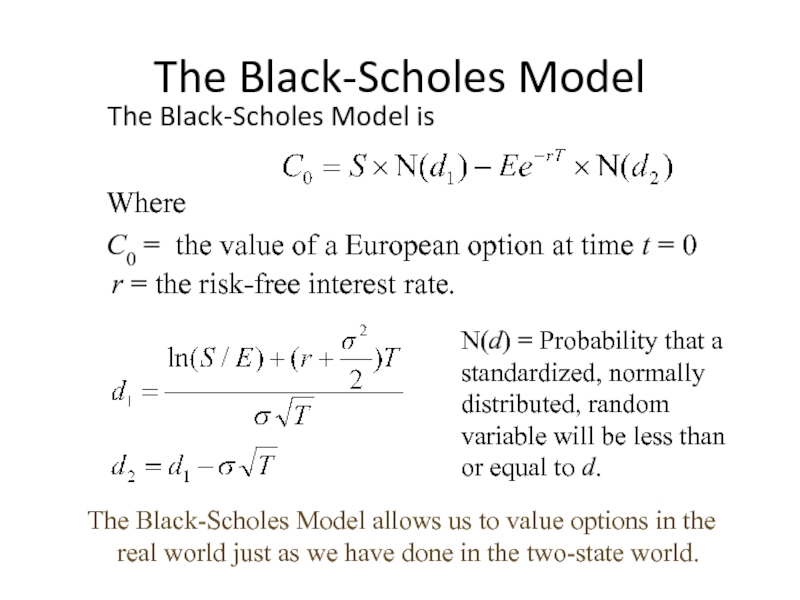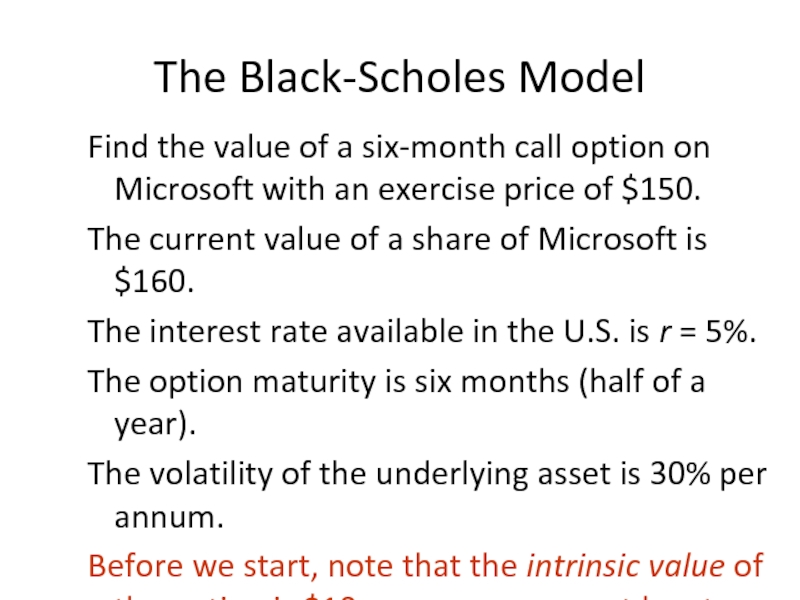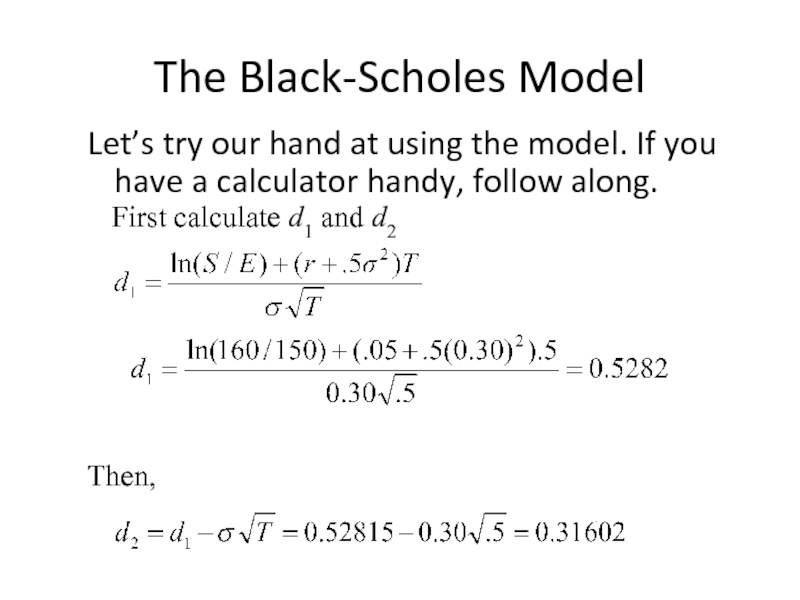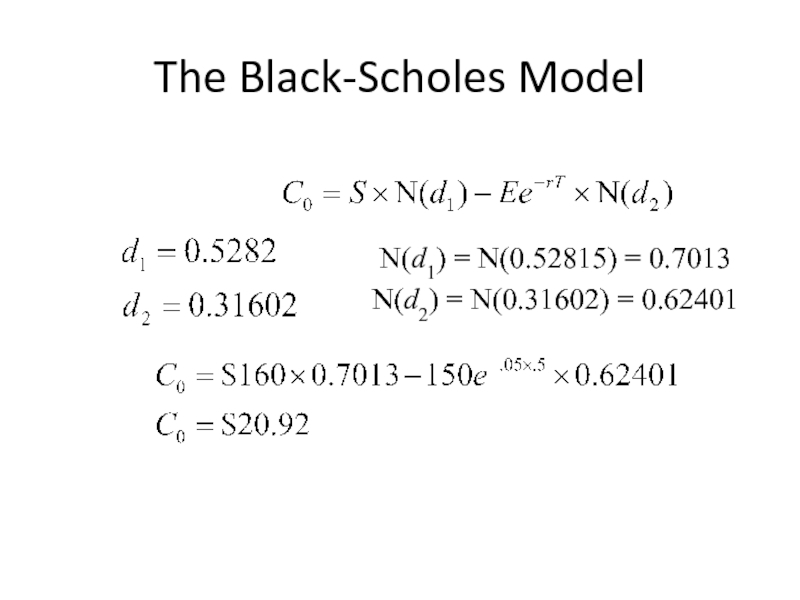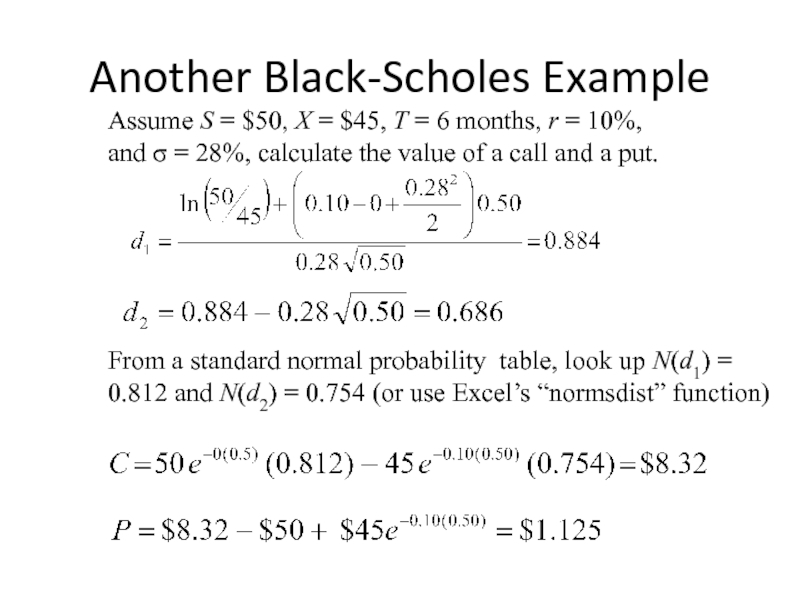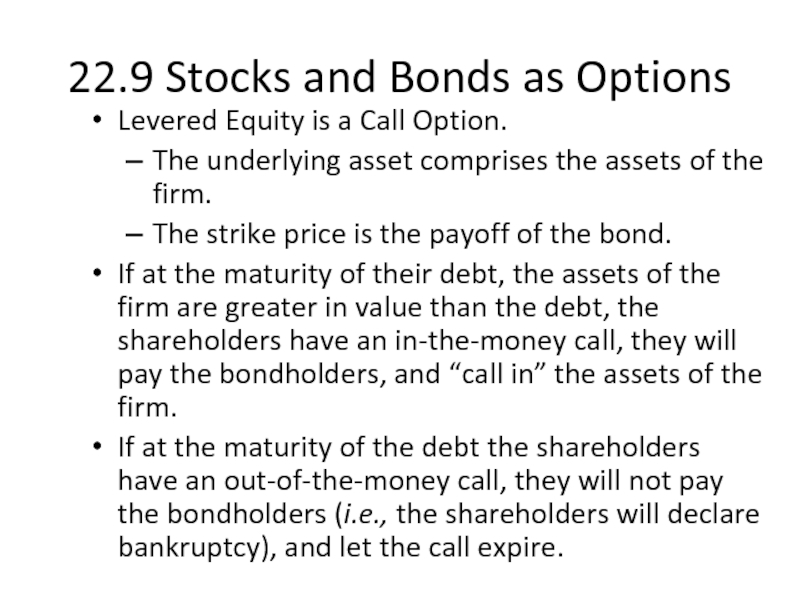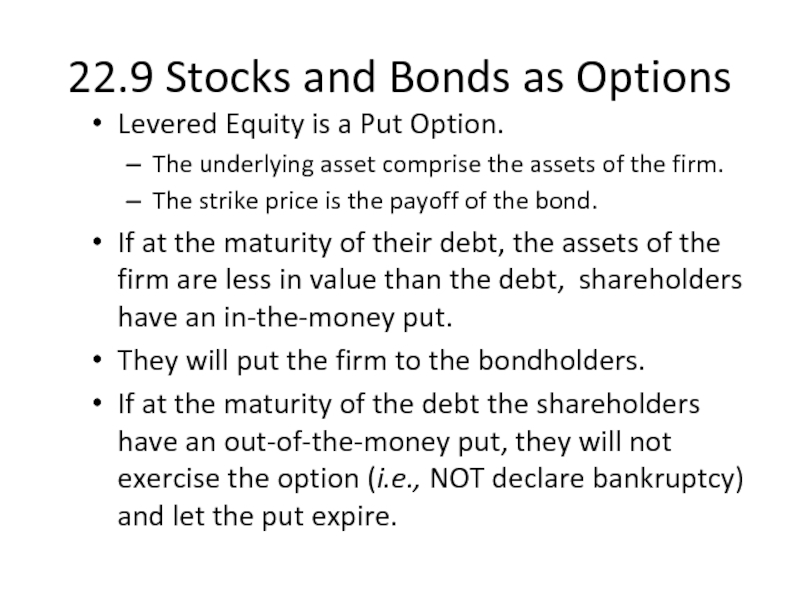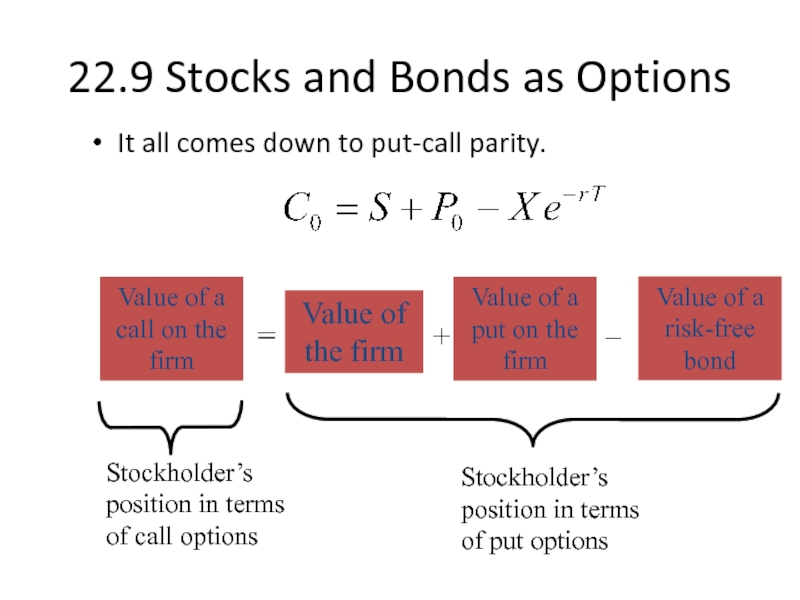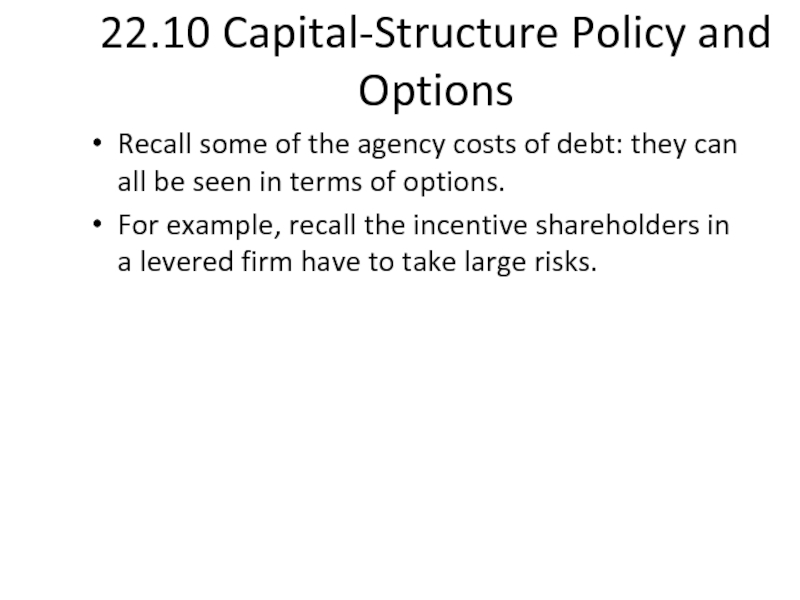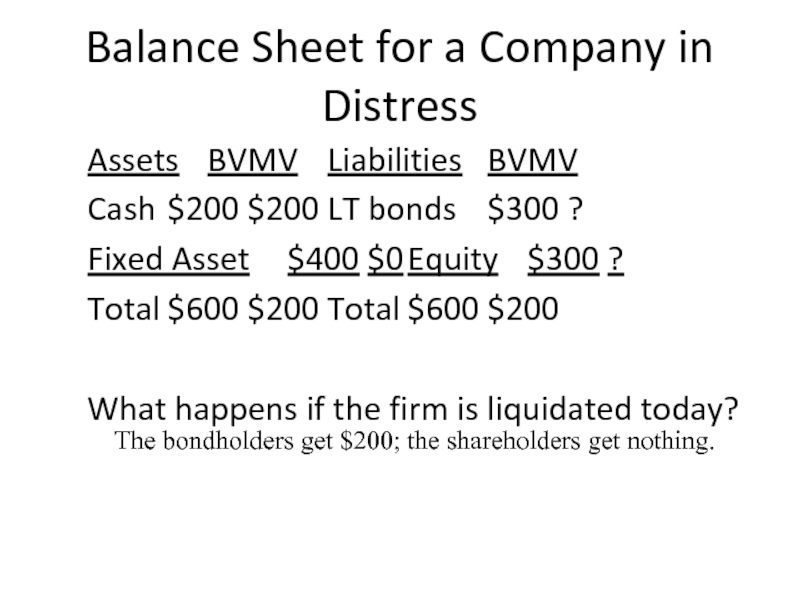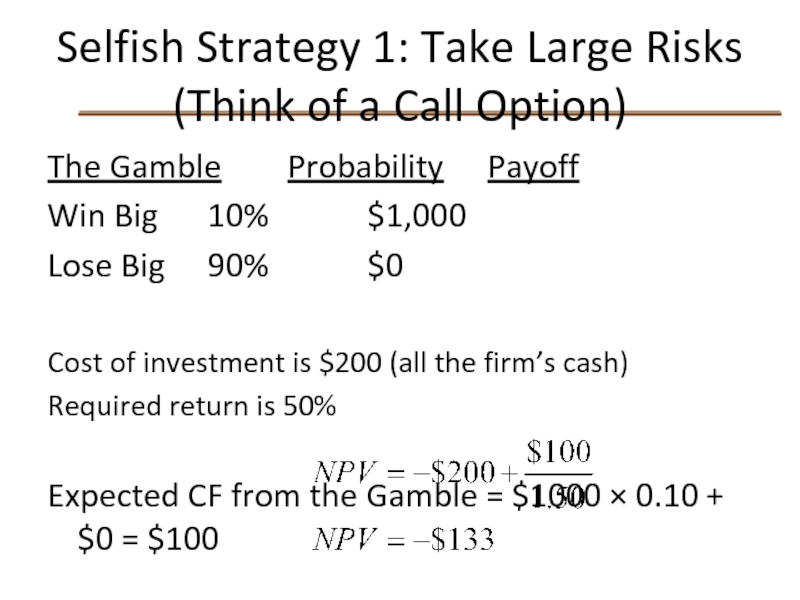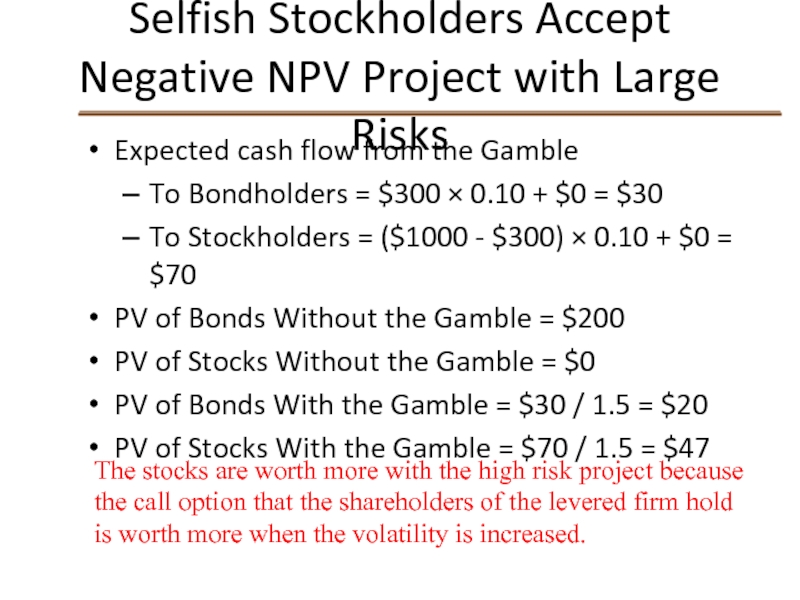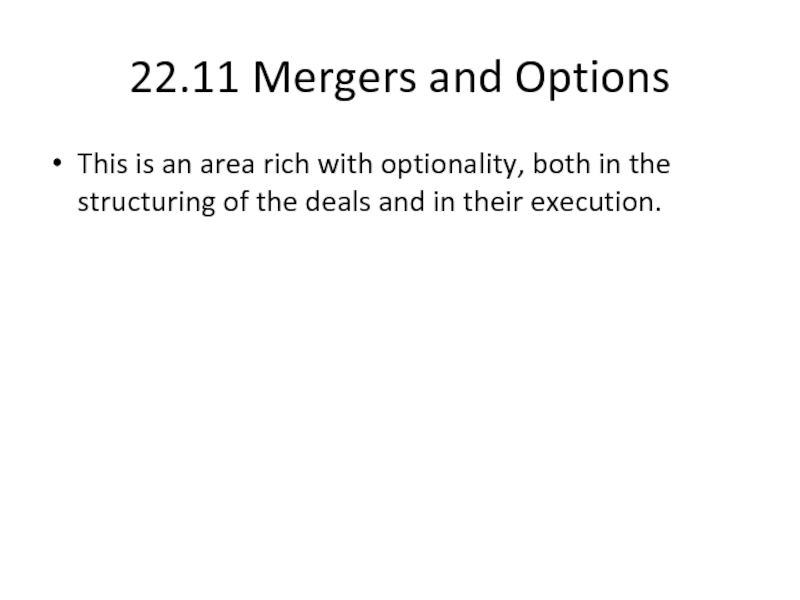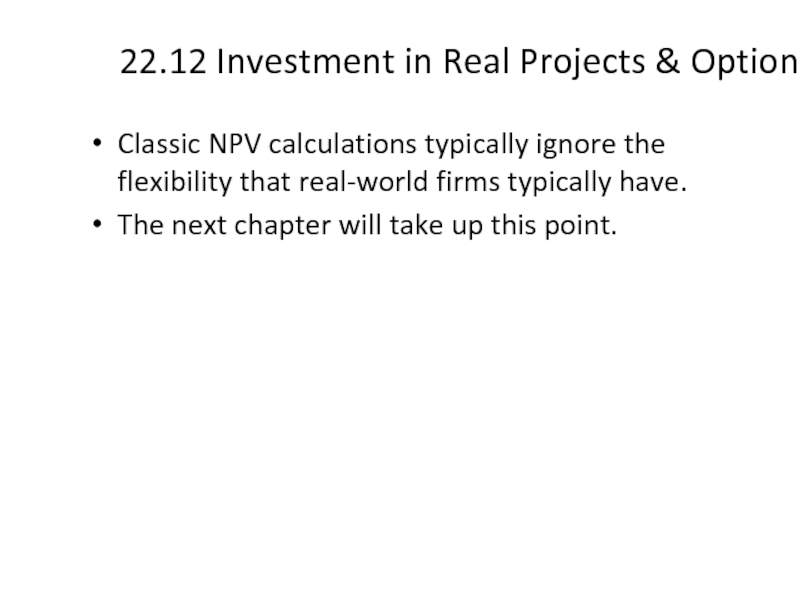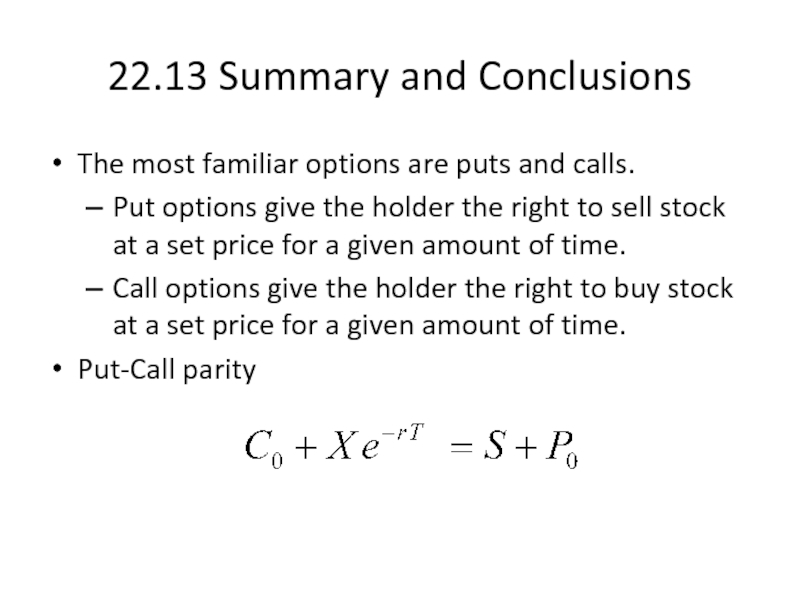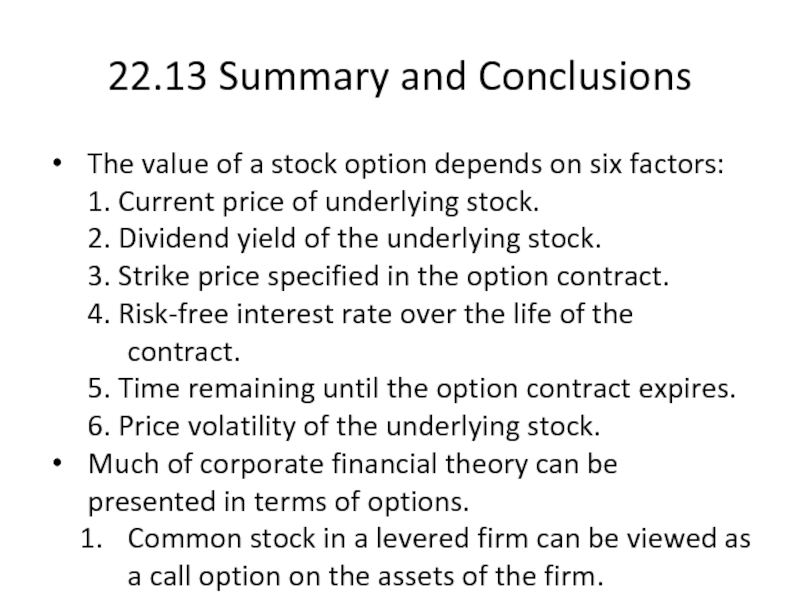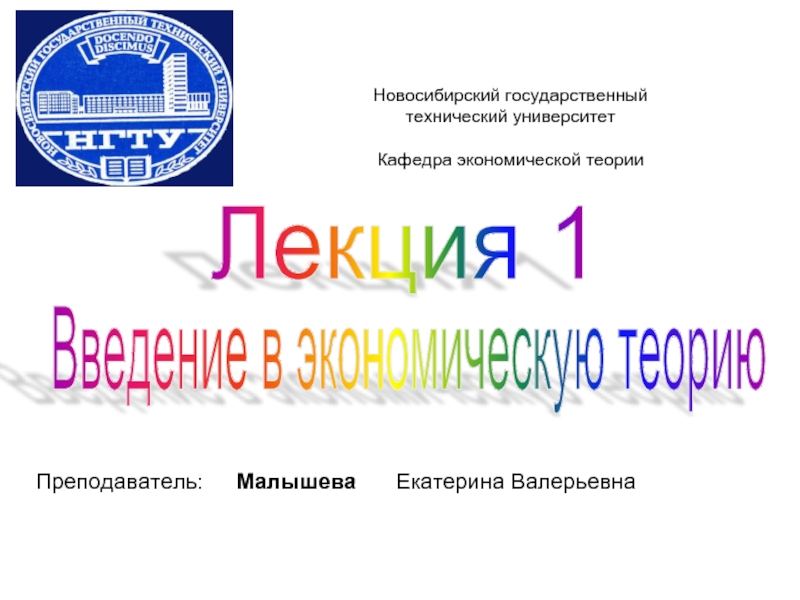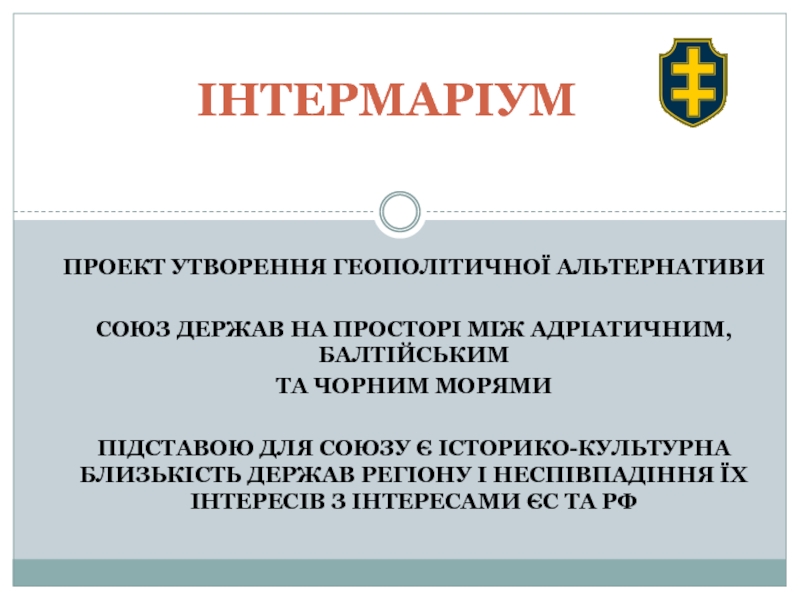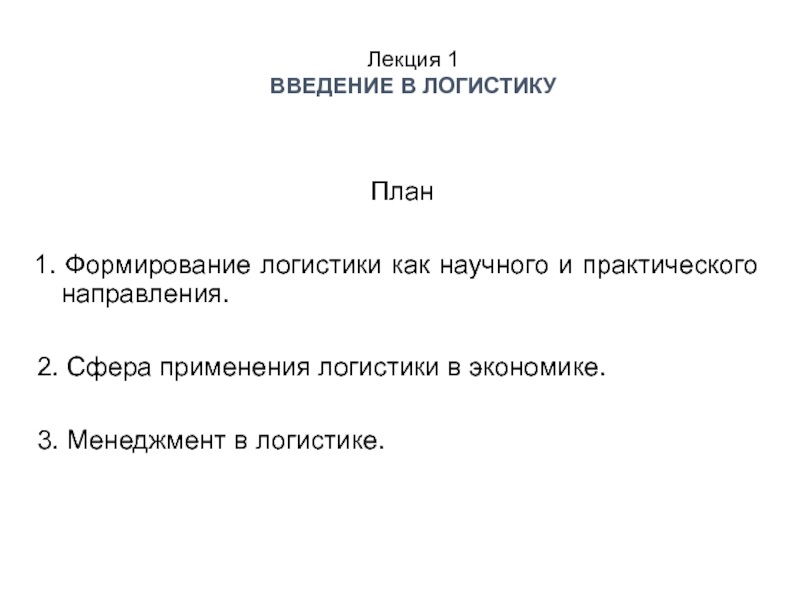- Главная
- Разное
- Дизайн
- Бизнес и предпринимательство
- Аналитика
- Образование
- Развлечения
- Красота и здоровье
- Финансы
- Государство
- Путешествия
- Спорт
- Недвижимость
- Армия
- Графика
- Культурология
- Еда и кулинария
- Лингвистика
- Английский язык
- Астрономия
- Алгебра
- Биология
- География
- Детские презентации
- Информатика
- История
- Литература
- Маркетинг
- Математика
- Медицина
- Менеджмент
- Музыка
- МХК
- Немецкий язык
- ОБЖ
- Обществознание
- Окружающий мир
- Педагогика
- Русский язык
- Технология
- Физика
- Философия
- Химия
- Шаблоны, картинки для презентаций
- Экология
- Экономика
- Юриспруденция
Options презентация
Содержание
- 1. Options
- 2. 22.1 Options Many corporate securities are similar
- 3. 22.1 Options Contracts: Preliminaries An option gives
- 4. 22.1 Options Contracts: Preliminaries Exercising the Option
- 5. Options Contracts: Preliminaries In-the-Money The exercise price
- 6. Options Contracts: Preliminaries Intrinsic Value The difference
- 7. 22.2 Call Options Call options gives the
- 8. Basic Call Option Pricing Relationships at Expiry
- 9. Call Option Payoffs -20 100 90 80
- 10. Call Option Payoffs Write a call Exercise price = $50
- 11. Call Option Profits Write a call Buy
- 12. 22.3 Put Options Put options give the
- 13. Basic Put Option Pricing Relationships at Expiry
- 14. Put Option Payoffs -20 100 90 80
- 15. Put Option Payoffs -20 100 90 80
- 16. Put Option Profits -20 100 90 80
- 17. 22.4 Selling Options The seller (or writer)
- 18. 22.5 Stock Option Quotations
- 19. 22.5 Stock Option Quotations This option has
- 20. 22.5 Stock Option Quotations This makes a
- 21. 22.5 Stock Option Quotations On this
- 22. 22.5 Stock Option Quotations The holder of
- 23. 22.5 Stock Option Quotations Buying this CALL
- 24. 22.5 Stock Option Quotations On this
- 25. 22.6 Combinations of Options Puts and calls
- 26. Protective Put Strategy: Buy a Put
- 27. Protective Put Strategy Profits Buy a put
- 28. Covered Call Strategy Sell a call with
- 29. Long Straddle: Buy a Call and a
- 30. Short Straddle: Sell a Call and a
- 31. Long Call Spread Sell a call with
- 32. Put-Call Parity Sell a put with an
- 33. 22.7 Valuing Options The last section concerned
- 34. Option Value Determinants Call Put Stock
- 35. Market Value, Time Value,
- 36. 22.8 An Option‑Pricing Formula We will start
- 37. Binomial Option Pricing Model Suppose a
- 38. Binomial Option Pricing Model A call option
- 39. Binomial Option Pricing Model Borrow the present
- 40. Binomial Option Pricing Model The
- 41. Binomial Option Pricing Model We can value
- 42. The Binomial Option Pricing Model If the
- 43. The Binomial Option Pricing Model If the
- 44. Binomial Option Pricing Model the replicating portfolio
- 45. The Risk-Neutral Approach to Valuation We could
- 46. The Risk-Neutral Approach to Valuation S(0)
- 47. The Risk-Neutral Approach to Valuation The key
- 48. Example of the Risk-Neutral Valuation of a
- 49. Example of the Risk-Neutral Valuation of a
- 50. Example of the Risk-Neutral Valuation of a
- 51. Example of the Risk-Neutral Valuation of a
- 52. Risk-Neutral Valuation and the Replicating Portfolio This
- 53. The Black-Scholes Model The Black-Scholes Model is
- 54. The Black-Scholes Model Find the value of
- 55. The Black-Scholes Model Let’s try our hand
- 56. The Black-Scholes Model N(d1) = N(0.52815) = 0.7013 N(d2) = N(0.31602) = 0.62401
- 57. Assume S = $50, X = $45,
- 58. 22.9 Stocks and Bonds as Options Levered
- 59. 22.9 Stocks and Bonds as Options Levered
- 60. 22.9 Stocks and Bonds as Options It
- 61. 22.10 Capital-Structure Policy and Options Recall some
- 62. Balance Sheet for a Company in Distress
- 63. Selfish Strategy 1: Take Large Risks
- 64. Selfish Stockholders Accept Negative NPV Project
- 65. 22.11 Mergers and Options This is an
- 66. 22.12 Investment in Real Projects & Options
- 67. 22.13 Summary and Conclusions The most familiar
- 68. 22.13 Summary and Conclusions The value of
Слайд 122.1 Options
22.2 Call Options
22.3 Put Options
22.4 Selling Options
22.5 Stock Option Quotations
22.6
22.7 Valuing Options
22.8 An Option‑Pricing Formula
22.9 Stocks and Bonds as Options
22.10 Capital-Structure Policy and Options
22.11 Mergers and Options
22.12 Investment in Real Projects and Options
22.13 Summary and Conclusions
Слайд 222.1 Options
Many corporate securities are similar to the stock options that
Almost every issue of corporate stocks and bonds has option features.
In addition, capital structure and capital budgeting decisions can be viewed in terms of options.
Слайд 322.1 Options Contracts: Preliminaries
An option gives the holder the right, but
Calls versus Puts
Call options gives the holder the right, but not the obligation, to buy a given quantity of some asset at some time in the future, at prices agreed upon today. When exercising a call option, you “call in” the asset.
Put options gives the holder the right, but not the obligation, to sell a given quantity of an asset at some time in the future, at prices agreed upon today. When exercising a put, you “put” the asset to someone.
Слайд 422.1 Options Contracts: Preliminaries
Exercising the Option
The act of buying or selling
Strike Price or Exercise Price
Refers to the fixed price in the option contract at which the holder can buy or sell the underlying asset.
Expiry
The maturity date of the option is referred to as the expiration date, or the expiry.
European versus American options
European options can be exercised only at expiry.
American options can be exercised at any time up to expiry.
Слайд 5Options Contracts: Preliminaries
In-the-Money
The exercise price is less than the spot price
At-the-Money
The exercise price is equal to the spot price of the underlying asset.
Out-of-the-Money
The exercise price is more than the spot price of the underlying asset.
Слайд 6Options Contracts: Preliminaries
Intrinsic Value
The difference between the exercise price of the
Speculative Value
The difference between the option premium and the intrinsic value of the option.
Option Premium
=
Intrinsic Value
Speculative Value
+
Слайд 722.2 Call Options
Call options gives the holder the right, but not
When exercising a call option, you “call in” the asset.
Слайд 8Basic Call Option Pricing Relationships at Expiry
At expiry, an American call
If the call is in-the-money, it is worth ST - E.
If the call is out-of-the-money, it is worthless.
CaT = CeT = Max[ST - E, 0]
Where
ST is the value of the stock at expiry (time T)
E is the exercise price.
CaT is the value of an American call at expiry
CeT is the value of a European call at expiry
Слайд 9Call Option Payoffs
-20
100
90
80
70
60
0
10
20
30
40
50
-40
20
0
-60
40
60
Stock price ($)
Option payoffs ($)
Buy a call
Exercise price =
Слайд 1222.3 Put Options
Put options give the holder the right, but not
When exercising a put, you “put” the asset to someone.
Слайд 13Basic Put Option Pricing Relationships at Expiry
At expiry, an American put
If the put is in-the-money, it is worth E - ST.
If the put is out-of-the-money, it is worthless.
PaT = PeT = Max[E - ST, 0]
Слайд 14Put Option Payoffs
-20
100
90
80
70
60
0
10
20
30
40
50
-40
20
0
-60
40
60
Stock price ($)
Option payoffs ($)
Buy a put
Exercise price =
Слайд 15Put Option Payoffs
-20
100
90
80
70
60
0
10
20
30
40
50
-40
20
0
-60
40
60
Option payoffs ($)
write a put
Exercise price = $50
Stock price
Слайд 16Put Option Profits
-20
100
90
80
70
60
0
10
20
30
40
50
-40
20
0
-60
40
60
Stock price ($)
Option profits ($)
Buy a put
Write a put
Exercise
10
-10
Слайд 1722.4 Selling Options
The seller (or writer) of an option has an
The purchaser of an option has an option.
Слайд 1922.5 Stock Option Quotations
This option has a strike price of $8;
A
June is the expiration month
Слайд 2022.5 Stock Option Quotations
This makes a call option with this exercise
Puts with this exercise price are out-of-the-money.
Слайд 2122.5 Stock Option Quotations
On this day, 15 call options with this
Слайд 2222.5 Stock Option Quotations
The holder of this CALL option can sell
Since the option is on 100 shares of stock, selling this option would yield $195.
Слайд 2322.5 Stock Option Quotations
Buying this CALL option costs $2.10.
Since the option
Слайд 2422.5 Stock Option Quotations
On this day, there were 660 call options
Слайд 2522.6 Combinations of Options
Puts and calls can serve as the building
If you understand this, you can become a financial engineer, tailoring the risk-return profile to meet your client’s needs.
Слайд 26
Protective Put Strategy: Buy a Put and Buy the Underlying Stock:
Buy a put with an exercise price of $50
Buy the stock
Protective Put strategy has downside protection and upside potential
$50
$0
$50
Value at expiry
Value of stock at expiry
Слайд 27Protective Put Strategy Profits
Buy a put with exercise price of $50
Buy the stock at $40
$40
Protective Put strategy has downside protection and upside potential
$40
$0
-$40
$50
Value at expiry
Value of stock at expiry
Слайд 28Covered Call Strategy
Sell a call with exercise price of $50 for
Buy the stock at $40
$40
Covered call
$40
$0
-$40
$10
-$30
$30
$50
Value of stock at expiry
Value at expiry
Слайд 29Long Straddle: Buy a Call and a Put
Buy a put with
$40
A Long Straddle only makes money if the stock price moves $20 away from $50.
$40
$0
-$20
$50
Buy a call with an exercise price of $50 for $10
-$10
$30
$60
$30
$70
Value of stock at expiry
Value at expiry
Слайд 30Short Straddle: Sell a Call and a Put
Sell a put with
$50 for $10
$40
A Short Straddle only loses money if the stock price moves $20 away from $50.
-$40
$0
-$30
$50
Sell a call with an
exercise price of $50 for $10
$10
$20
$60
$30
$70
Value of stock at expiry
Value at expiry
Слайд 31Long Call Spread
Sell a call with exercise price of $55 for
$55
long call spread
$5
$0
$50
Buy a call with an exercise price of $50 for $10
-$10
-$5
$60
Value of stock at expiry
Value at expiry
Слайд 32Put-Call Parity
Sell a put with an exercise price of $40
Buy the
Buy a call option with an exercise price of $40
$0
-$40
$40-P0
$40
Buy the stock at $40
-[$40-P0]
In market equilibrium, it mast be the case that option prices are set such that:
Otherwise, riskless portfolios with positive payoffs exist.
Value of stock at expiry
Value at expiry
Слайд 3322.7 Valuing Options
The last section concerned itself with the value of
This section considers the value of an option prior to the expiration date.
A much more interesting question.
Слайд 34Option Value Determinants
Call Put
Stock price + –
Exercise price – +
Interest rate +
Volatility in the stock price + +
Expiration date + +
The value of a call option C0 must fall within
max (S0 – E, 0) < C0 < S0.
The precise position will depend on these factors.
Слайд 35
Market Value, Time Value, and Intrinsic Value for an American Call
CaT
Profit
loss
E
ST
Market Value
Intrinsic value
ST - E
Time value
Out-of-the-money
In-the-money
ST
The value of a call option C0 must fall within max (S0 – E, 0) < C0 < S0.
Слайд 3622.8 An Option‑Pricing Formula
We will start with a binomial option pricing
Then we will graduate to the normal approximation to the binomial for some real-world option valuation.
Слайд 37
Binomial Option Pricing Model
Suppose a stock is worth $25 today and
$25
$21.25
$28.75
S1
S0
Слайд 38Binomial Option Pricing Model
A call option on this stock with exercise
We can replicate the payoffs of the call option. With a levered position in the stock.
$25
$21.25
$28.75
S1
S0
C1
$3.75
$0
Слайд 39Binomial Option Pricing Model
Borrow the present value of $21.25 today and
The net payoff for this levered equity portfolio in one period is either $7.50 or $0.
The levered equity portfolio has twice the option’s payoff so the portfolio is worth twice the call option value.
$25
$21.25
$28.75
S1
S0
debt
- $21.25
portfolio
$7.50
$0
( - ) =
=
=
C1
$3.75
$0
- $21.25
Слайд 40Binomial Option Pricing Model
The levered equity portfolio value today
$25
$21.25
$28.75
S1
S0
debt
- $21.25
portfolio
$7.50
$0
( - ) =
=
=
C1
$3.75
$0
- $21.25
Слайд 41Binomial Option Pricing Model
We can value the option today as half
$25
$21.25
$28.75
S1
S0
debt
- $21.25
portfolio
$7.50
$0
( - ) =
=
=
C1
$3.75
$0
- $21.25
Слайд 42The Binomial Option Pricing Model
If the interest rate is 5%, the
$25
$21.25
$28.75
S1
S0
debt
- $21.25
portfolio
$7.50
$0
( - ) =
=
=
C1
$3.75
$0
- $21.25
Слайд 43The Binomial Option Pricing Model
If the interest rate is 5%, the
$25
$21.25
$28.75
S1
S0
debt
- $21.25
portfolio
$7.50
$0
( - ) =
=
=
C1
$3.75
$0
- $21.25
Слайд 44Binomial Option Pricing Model
the replicating portfolio intuition.
Many derivative securities can be
The most important lesson (so far) from the binomial option pricing model is:
Слайд 45The Risk-Neutral Approach to Valuation
We could value V(0) as the value
S(0), V(0)
S(U), V(U)
S(D), V(D)
q
1- q
Слайд 46
The Risk-Neutral Approach to Valuation
S(0) is the value of the underlying
S(0), V(0)
S(U), V(U)
S(D), V(D)
S(U) and S(D) are the values of the asset in the next period following an up move and a down move, respectively.
q
1- q
V(U) and V(D) are the values of the asset in the next period following an up move and a down move, respectively.
q is the risk-neutral probability of an “up” move.
Слайд 47The Risk-Neutral Approach to Valuation
The key to finding q is to
A minor bit of algebra yields:
Слайд 48Example of the Risk-Neutral Valuation of a Call:
Suppose a stock is
The binomial tree would look like this:
$21.25,C(D)
q
1- q
$25,C(0)
$28.75,C(D)
Слайд 49Example of the Risk-Neutral Valuation of a Call:
The next step would
$21.25,C(D)
2/3
1/3
$25,C(0)
$28.75,C(D)
Слайд 50Example of the Risk-Neutral Valuation of a Call:
After that, find the
$21.25, $0
2/3
1/3
$25,C(0)
$28.75, $3.75
Слайд 51Example of the Risk-Neutral Valuation of a Call:
Finally, find the value
$25,$2.38
Слайд 52Risk-Neutral Valuation and the Replicating Portfolio
This risk-neutral result is consistent with
Слайд 53The Black-Scholes Model
The Black-Scholes Model is
Where
C0 = the value of a
r = the risk-free interest rate.
N(d) = Probability that a standardized, normally distributed, random variable will be less than or equal to d.
The Black-Scholes Model allows us to value options in the real world just as we have done in the two-state world.
Слайд 54The Black-Scholes Model
Find the value of a six-month call option on
The current value of a share of Microsoft is $160.
The interest rate available in the U.S. is r = 5%.
The option maturity is six months (half of a year).
The volatility of the underlying asset is 30% per annum.
Before we start, note that the intrinsic value of the option is $10—our answer must be at least that amount.
Слайд 55The Black-Scholes Model
Let’s try our hand at using the model. If
Then,
First calculate d1 and d2
Слайд 57Assume S = $50, X = $45, T = 6 months,
and σ = 28%, calculate the value of a call and a put.
From a standard normal probability table, look up N(d1) = 0.812 and N(d2) = 0.754 (or use Excel’s “normsdist” function)
Another Black-Scholes Example
Слайд 5822.9 Stocks and Bonds as Options
Levered Equity is a Call Option.
The
The strike price is the payoff of the bond.
If at the maturity of their debt, the assets of the firm are greater in value than the debt, the shareholders have an in-the-money call, they will pay the bondholders, and “call in” the assets of the firm.
If at the maturity of the debt the shareholders have an out-of-the-money call, they will not pay the bondholders (i.e., the shareholders will declare bankruptcy), and let the call expire.
Слайд 5922.9 Stocks and Bonds as Options
Levered Equity is a Put Option.
The
The strike price is the payoff of the bond.
If at the maturity of their debt, the assets of the firm are less in value than the debt, shareholders have an in-the-money put.
They will put the firm to the bondholders.
If at the maturity of the debt the shareholders have an out-of-the-money put, they will not exercise the option (i.e., NOT declare bankruptcy) and let the put expire.
Слайд 6022.9 Stocks and Bonds as Options
It all comes down to put-call
Stockholder’s position in terms of call options
Stockholder’s position in terms of put options
Слайд 6122.10 Capital-Structure Policy and Options
Recall some of the agency costs of
For example, recall the incentive shareholders in a levered firm have to take large risks.
Слайд 62Balance Sheet for a Company in Distress
Assets BV MV Liabilities BV MV
Cash $200 $200 LT bonds $300 ?
Fixed Asset $400 $0 Equity $300 ?
Total $600 $200 Total $600 $200
What happens if
The bondholders get $200; the shareholders get nothing.
Слайд 63
Selfish Strategy 1: Take Large Risks
(Think of a Call Option)
The
Win Big 10% $1,000
Lose Big 90% $0
Cost of investment is $200 (all the firm’s cash)
Required return is 50%
Expected CF from the Gamble = $1000 × 0.10 + $0 = $100
Слайд 64
Selfish Stockholders Accept Negative NPV Project with Large Risks
Expected cash flow
To Bondholders = $300 × 0.10 + $0 = $30
To Stockholders = ($1000 - $300) × 0.10 + $0 = $70
PV of Bonds Without the Gamble = $200
PV of Stocks Without the Gamble = $0
PV of Bonds With the Gamble = $30 / 1.5 = $20
PV of Stocks With the Gamble = $70 / 1.5 = $47
The stocks are worth more with the high risk project because the call option that the shareholders of the levered firm hold is worth more when the volatility is increased.
Слайд 6522.11 Mergers and Options
This is an area rich with optionality, both
Слайд 6622.12 Investment in Real Projects & Options
Classic NPV calculations typically ignore
The next chapter will take up this point.
Слайд 6722.13 Summary and Conclusions
The most familiar options are puts and calls.
Put
Call options give the holder the right to buy stock at a set price for a given amount of time.
Put-Call parity
Слайд 6822.13 Summary and Conclusions
The value of a stock option depends on
1. Current price of underlying stock.
2. Dividend yield of the underlying stock.
3. Strike price specified in the option contract.
4. Risk-free interest rate over the life of the contract.
5. Time remaining until the option contract expires.
6. Price volatility of the underlying stock.
Much of corporate financial theory can be presented in terms of options.
Common stock in a levered firm can be viewed as a call option on the assets of the firm.
Real projects often have hidden options that enhance value.
